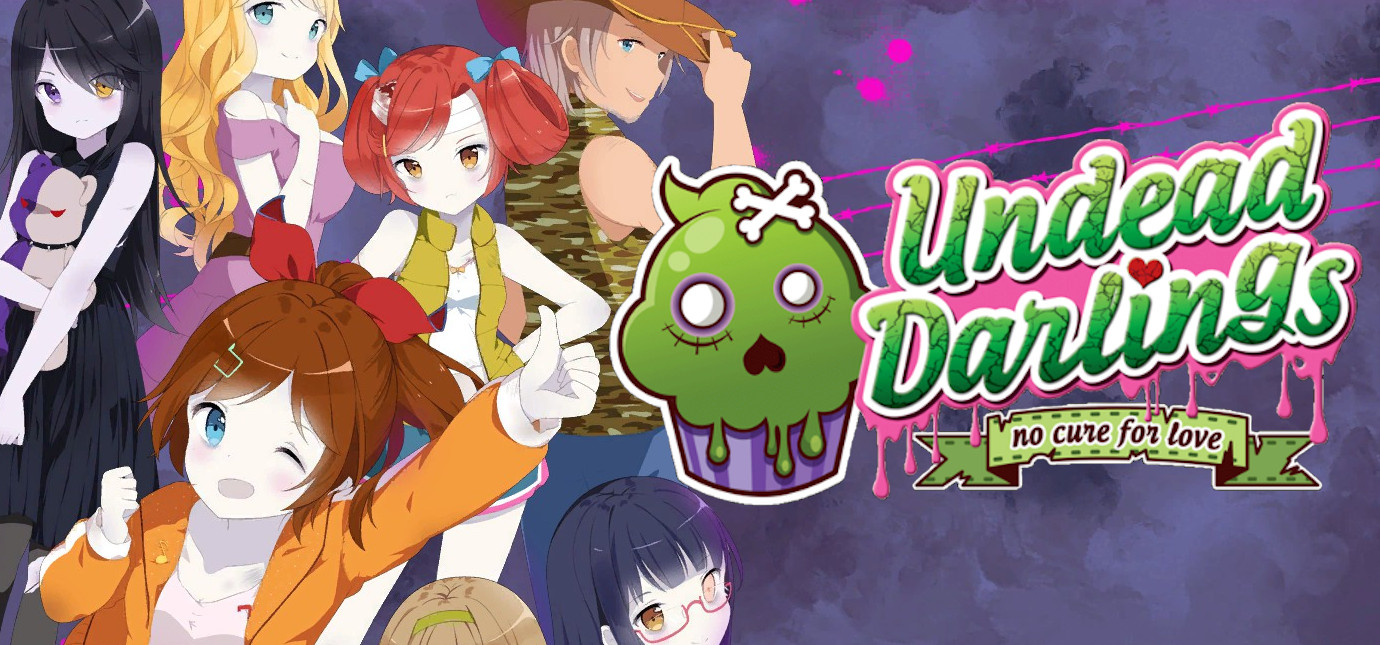Pseudo-anime zomboob joke goes here.
Type: Single-player
Genre: RPG, Visual Novel
Developer: Mr. Tired Media
Publisher: Sekai Project
Release date: TBA


Intro
In my last review, I covered Real Life Plus Ver. Kaname Komatsuzaki, a Japanese visual novel about a loser male character whose childhood friend fell in love with him before the story even started and with whom he shares lots of pop culture reference jokes. This week, we cover Undead Darlings, a Japanese-inspired western visual novel about a loser male character whose childhood friends fell in love with him before the story even started and with whom he shares lots of pop culture reference jokes but this time, they’re cutesy anime-style zombies. Plus, the visual novel is repeatedly interrupted by lengthy dungeon crawly bits.
Undead Darlings bills itself as being a Visual Novel and an RPG in one, which, since RPGs are already heavily story-driven, essentially just means “it’s an RPG with longer story bits that have more multiple choice in them”. With that said, there is a pretty serious effort made to distinguish the two modes of gameplay more than most RPGs not made by SquareSoft will do, so I have to bring in the old maxim that having games that blend very distinct gameplay modes is a dangerous gambit, since if you have a game that sticks solely to one mode of gameplay and put all your effort into doing it well, you likely end up with a game that can shine in its specific genre, while a game that tries to bring multiple genres together can wind up either forcing fans of one genre through gameplay they don’t like to get to the parts they do like, or else having one part of the game be so rushed and shallow that it drags the great parts of the game down when it has to be put next to the shallow minigames.
Yes, It’s ANOTHER Zombie Game
In TV Tropes terms, zombies are, fittingly enough, an “Undead Horse Trope”, meaning a dead horse (a trope that is parodied more often than used straight) that somehow never actually dies and goes away, and instead continues to shamble on. This just keeps them relevant and more ripe for parody over how overused they are.
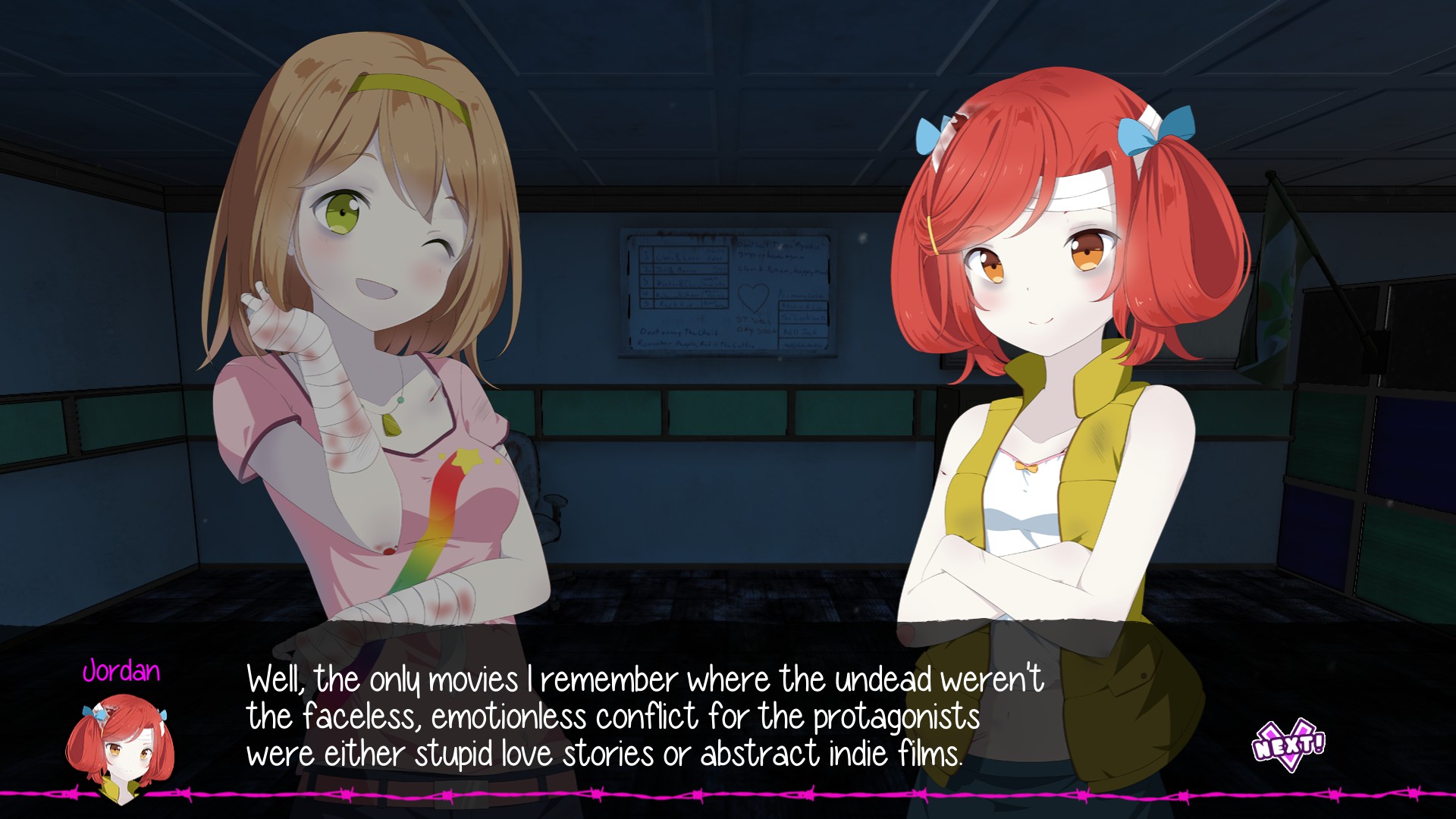
Undead Darlings follows the back-row inventory-carrying adventures of a lame generic lowest-common-denominator protagonist named “Reggie” as he follows behind the girls who make up the actual party and do the fighting. Ostensibly, this is to keep him from being bitten and infected while the girls are immune to even further zombification… although why none of the sneak attacks get any zombies near Reggie is not explained. Reggie’s father is a scientist who apparently is responsible for the outbreak in the first place, but also gave Reggie a cure before running off to a city leaving behind a trail of clues to his location to take the cure for mass-production to save humanity. He left his son behind with a stabilized half-zombie (Pearl) he wasn’t sure might not turn full zombie. Apparently, this was because he wanted to make sure there were as many points of potential failure for this plan as possible, like any rational scientist should do.
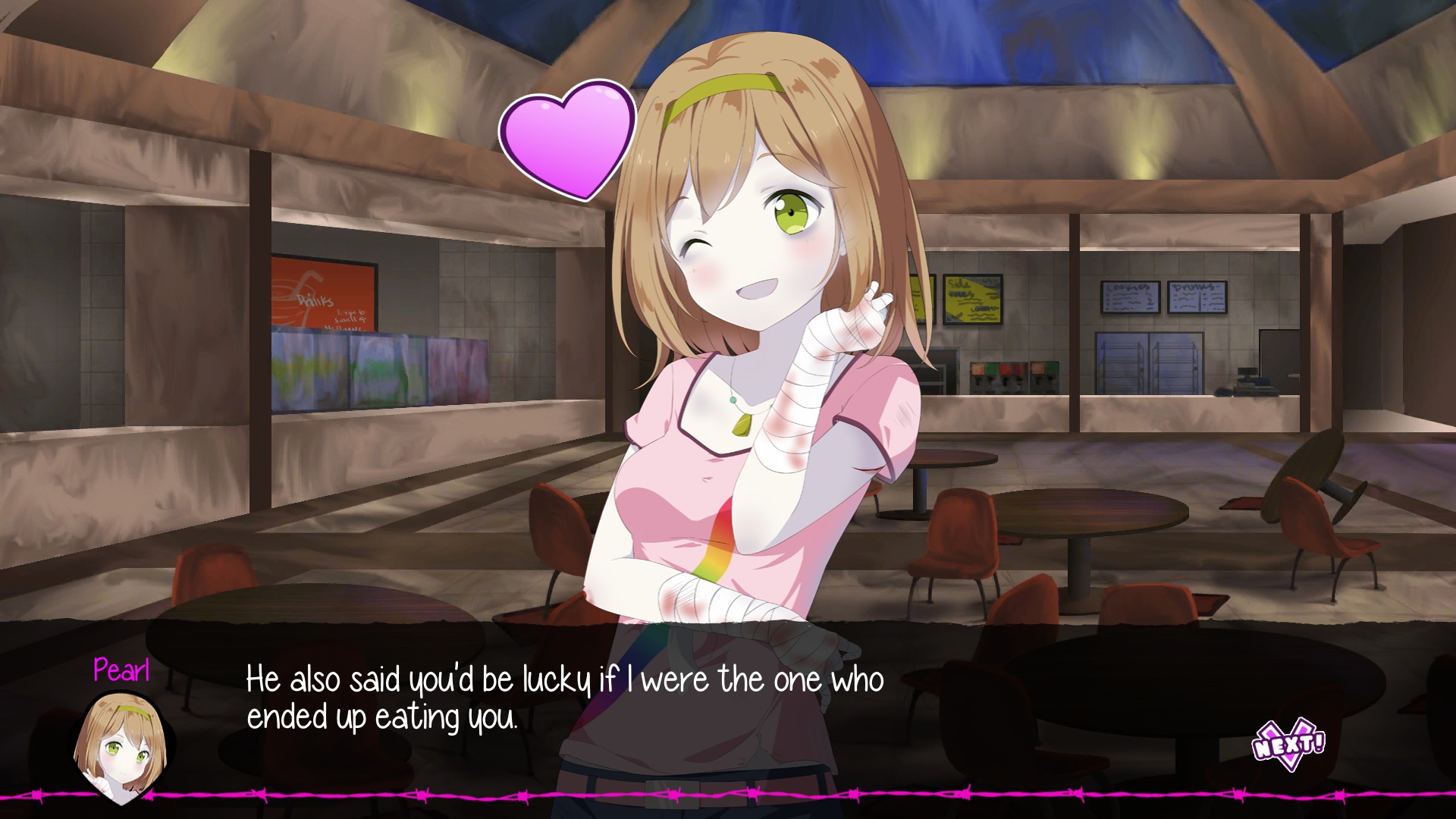
In order to get this potential cure to save all of humanity to mass production, you have to take a truck owned by a random passerby because your father took the only functioning vehicle himself when he left you behind a significant enough distance that the truck constantly breaks down or gets stuck in the abandoned cars on the freeway left behind by the zombie apocalypse. These, in Earthbound fashion, let you go through what are functional dungeons that were created when modern-day settings were attacked by zombies.
Naturally, being a game “inspired” by other horror films and games, it basically tries to recycle the settings they used, even if it no longer really makes sense in a modern context. Going through the zombie-filled police precinct, for example, is fine enough (I especially like the donut clocks that tell your actual computer clock time in-game), but the game also stops to go through a shopping mall (because that’s apparently a mandatory ritual at this point) to talk about fads of consumerism… that are already long-dead. I mean, malls are more commonly known for documentaries about “ghost malls” than actually being places people shop by this point.
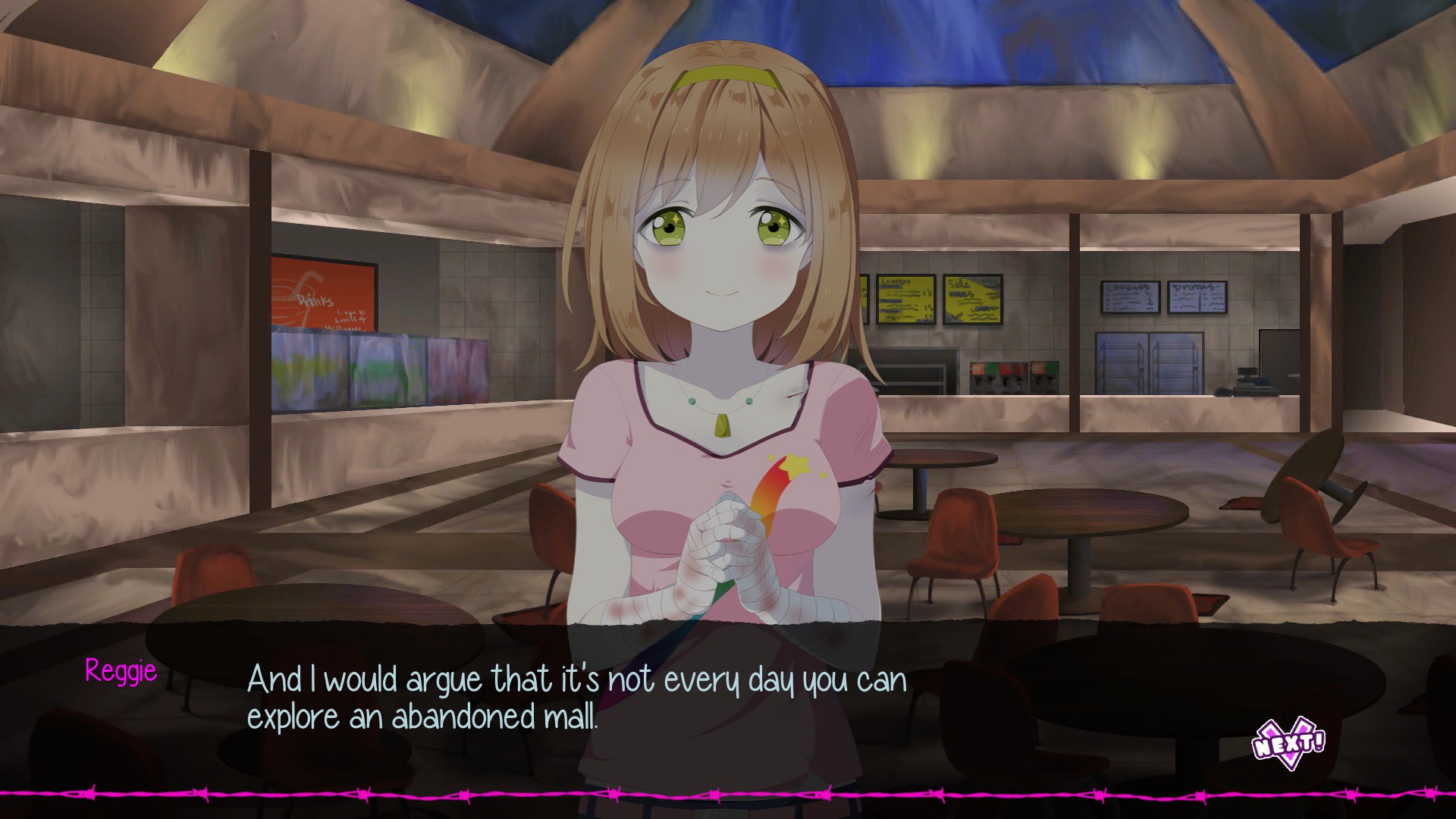
In case you’re wondering what the cause of this week’s zombie apocalypse is, I didn’t get far enough in to confirm it, but apparently the answer is “eugenics pseudo-science created zombies”.
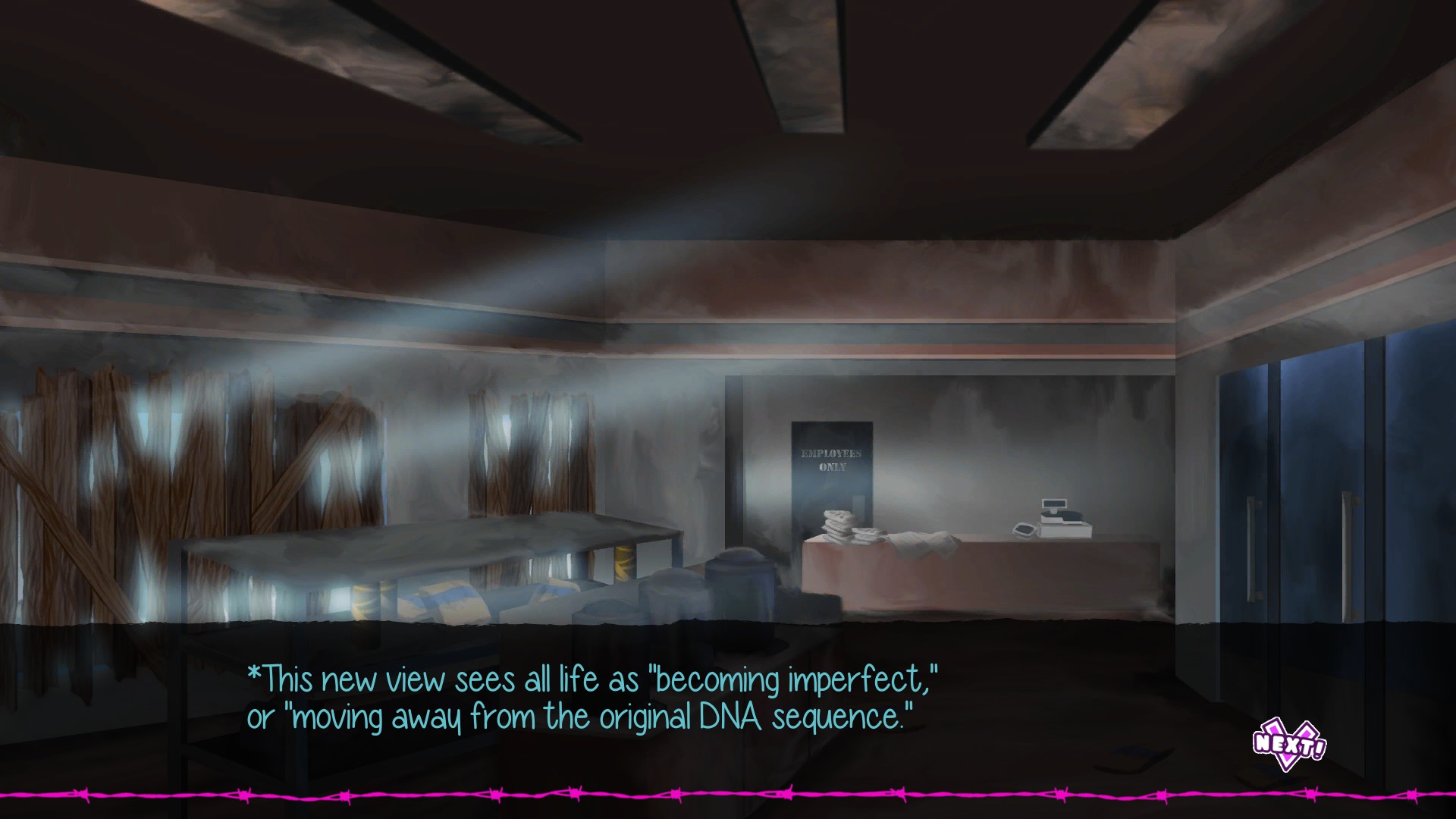
Comedy
The comedy in the game is rather inconsistent, shifting between the friendly banter of realistically-portrayed teenagers making pop culture references or teasing each other to teasing each other, to being completely unrealistic caricatures in other scenes, to having occasional moments of seriousness or romance, to having most of the equipment you find being gags where you pick up fuzzy handcuffs or police batons with weird descriptions in the police precinct, to having Deadpool-style arguments between the main character and the narrator over how they perceive reality leaving you as a reader highly confused.
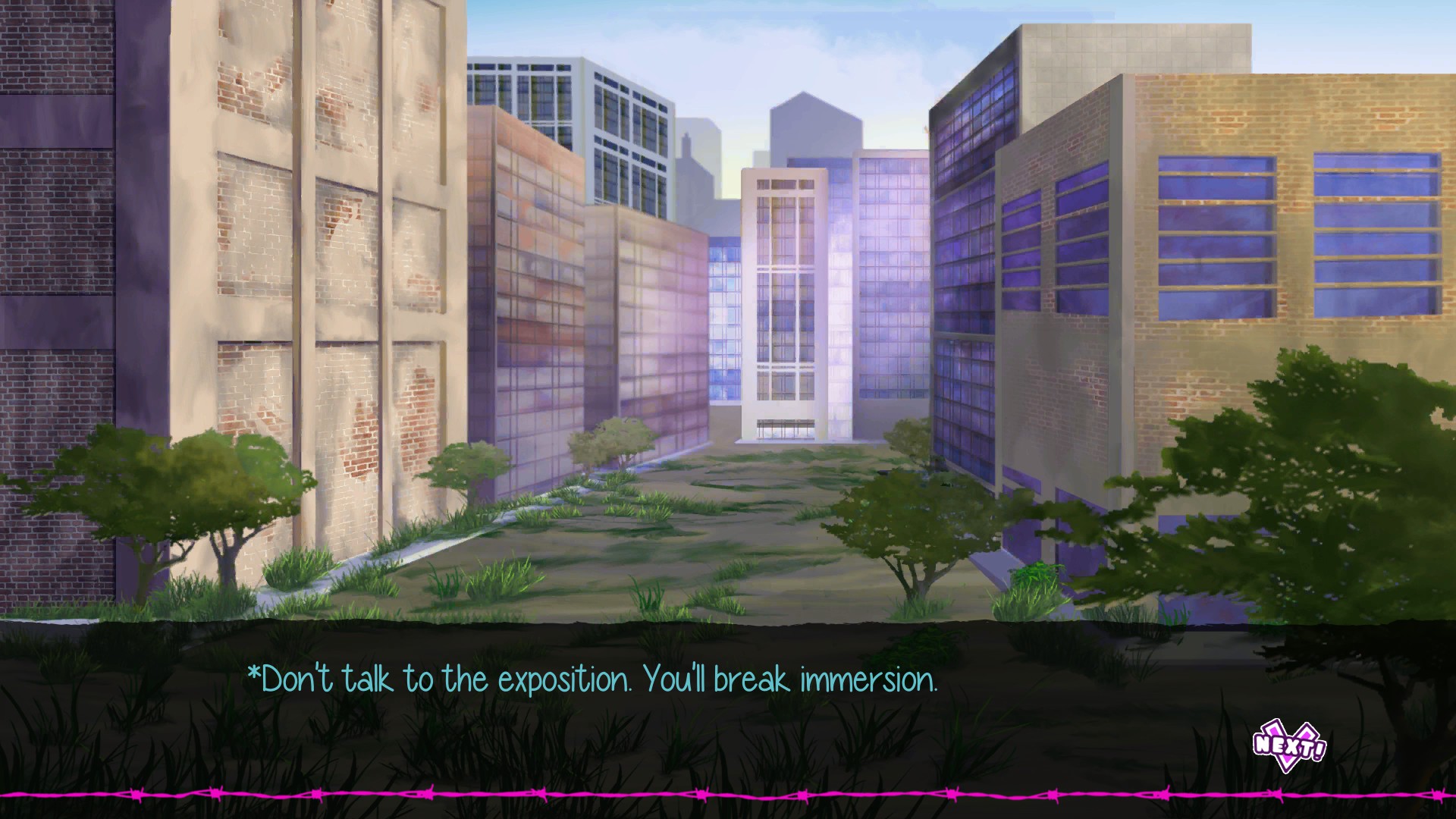
Also, for some reason, the writer apparently really hates hybrid vehicles and wants to vent it all over any audience they can get. It’s a running gag how much everyone except Buck hates them, and “jokes” about hybrids are a running “gag” like the audience is assumed to just automatically agree that simply saying how much you hate hybrids is some universal punchline that always gets laughs. I mean, I presume it’s supposed to be a joke because of the dramatic timing, but it’s just mystifying why this should be expected to be funny that everyone hates a hybrid truck for no reason.
In spite of many of the “jokes” not landing, and there being a nearly schizophrenic mood whiplash at points, the comedy is absolutely the selling point of the game, which lifts up the mediocre gameplay, but also undermines the romantic elements of the game.
The problem with a romantic comedy that tries to be too wacky is that romance only really works if you can take the characters seriously enough to consider them and their feelings as valid and realistic enough to contemplate being in a relationship with, which is a problem when characters are such extreme stereotypes they’re walking punchlines to jokes that get even less funny when you have to think about what it would be like to be a living stereotype. For characters like Pearl and Jordan, this isn’t so much a problem, but some characters, especially Cici, are just too out-there to take seriously for romance.
Romantic Comedy
So let’s discuss the characters/romantic options.
The story’s tonal issues also stem in no small part from the characters themselves seeming to belong in games with seriously different tones, and it creates this tonal dissonance when they’re in the same conversation together.
So first things first, let’s briefly discuss the main character, Reggie. In most stories, how they portray the main character that the audience is meant to project themselves onto is basically a barometer for what the writer assumes about the lowest common denominator of their audience. A power fantasy assumes you’d want to think you’d use your power the way the main character does. A comedy with a loser protagonist will have traits that the writer assumes everyone who would read/watch/play that media would have, so a black comedy will have a snarky and cynical protagonist because that’s what they assume the outlook of someone watching black comedy will be. Porn or dirty joke stories will tend to have a horny loser protagonist. Reggie is a loser that watches tons of trashy horror movies and shares tons of pop culture references with his friends. You’d better get it when one of the dialogue options is “You’re tearing me apart, Pearl!” with Jordan then replying “Oh, hi Reggie!”, because that’s basically a third of the humor.
Pearl is one of the two childhood friend love interests in this game, and the one that starts off the game waking you up because it’s an “Anime Inspired” game, so that means they’re doing overused cliches on purpose!
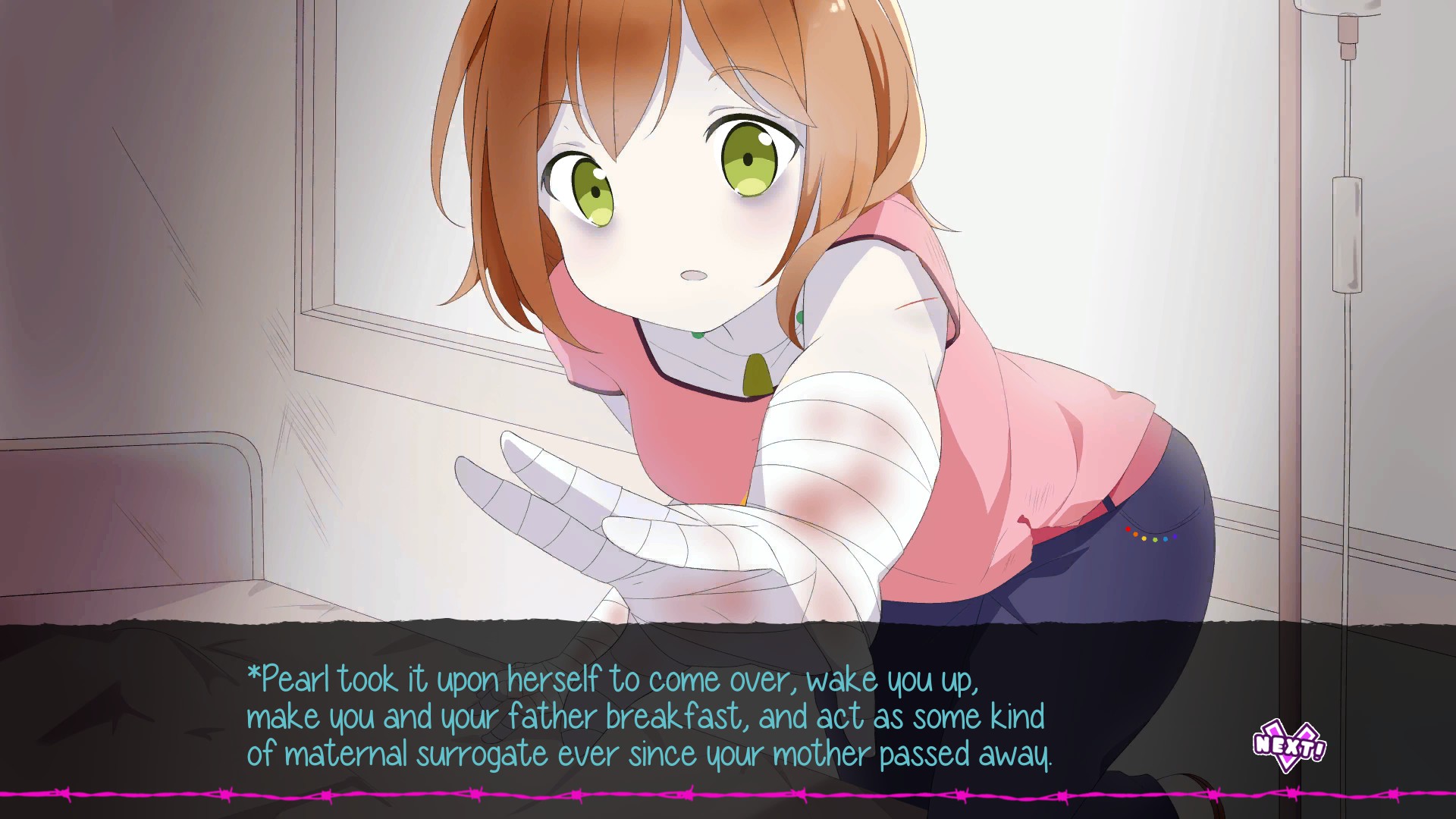
Pearl is the girly-girl childhood friend love interest who’s also the one who could not more clearly already think of herself as Reggie’s girlfriend to the point of getting jealous every time he talks to any other girl. Outside of teasing Jordan or Reggie or being teased herself, she’s not much of a source of real comedy. On the more serious side, she’s also the most averse to violence even against monsters in the cast because her father, who’s also the police chief, is apparently a violent man, and the story can slowly creep towards something serious when the topic comes up.
Jordan is Pearl’s cousin, and the tsundere childhood friend love interest. When she isn’t playing up being (one of) the tsundere(s) to the extreme, she’s otherwise one of the more naturally-speaking characters. When she’s talking about movies (and she supposedly has a small YouTube channel doing so), she sounds like a realistic, grounded character. As a childhood friend love interest, she also suffers from the mandate that she starts the game in love with Reggie and [sigh] gets jealous of Pearl being so close to him. Compared to Pearl, however, while Jordan isn’t blatantly already acting like Reggie’s housewife, their shared interests tend to give them more of a natural chemistry with each other. Like Pearl, she also can get more serious when the topic of parenting comes up (apparently, this universe runs on Fruits Basket’s “all parents are neglectful or abusive parents” mentality so everyone has childhood trauma to get over), she bitterly states that she’s pretty much a literal red-headed step child that was abandoned.
Between the two of them and Reggie, when it isn’t romantic anime cliche time, the story is very grounded, relatable, and realistic… and then you get the other characters behaving far more like cartoons. Considering the first two love interests are so well-established in their relationship with Reggie with no major impediments (besides each other) to romance, it just begs the question why Reggie would even consider any of the other love interests that happened to show up when he clearly has a good thing going with the two girls already in love with him.
Next up is the sole other male and other non-zombie character named… [sigh] Buck Wampum. In the Japanese versions of dating sims, especially ones based in high school, there’s always this other guy who’s a best friend of the main character, but who’s an even more obviously horny loser that the girls stay away from to make it clear he doesn’t threaten to steal one of the romantic interests away from the main character. Buck Wampum is that concept on steroids. He wears a Confederate cavalry hat and a camo vest while talking in the most exaggerated set of southern cliches that it almost comes across as some sort of racist caricature of southern people.
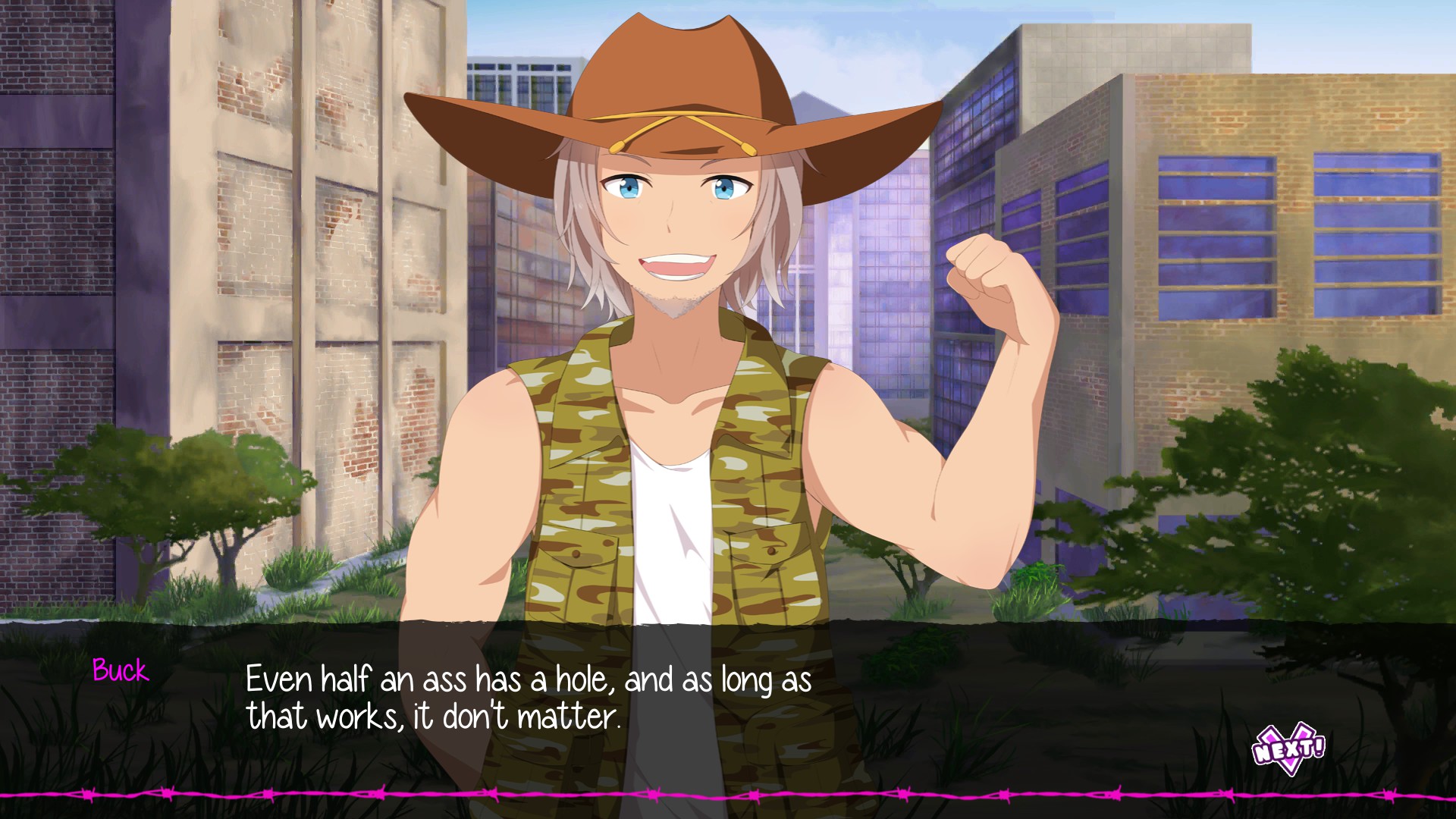
He’s so clearly an over-the-top comic relief character, I’m left wondering why they left it at “Buck Wampum” and didn’t go for the full MST3K naming system and just name him “Buck Wilde” or something.
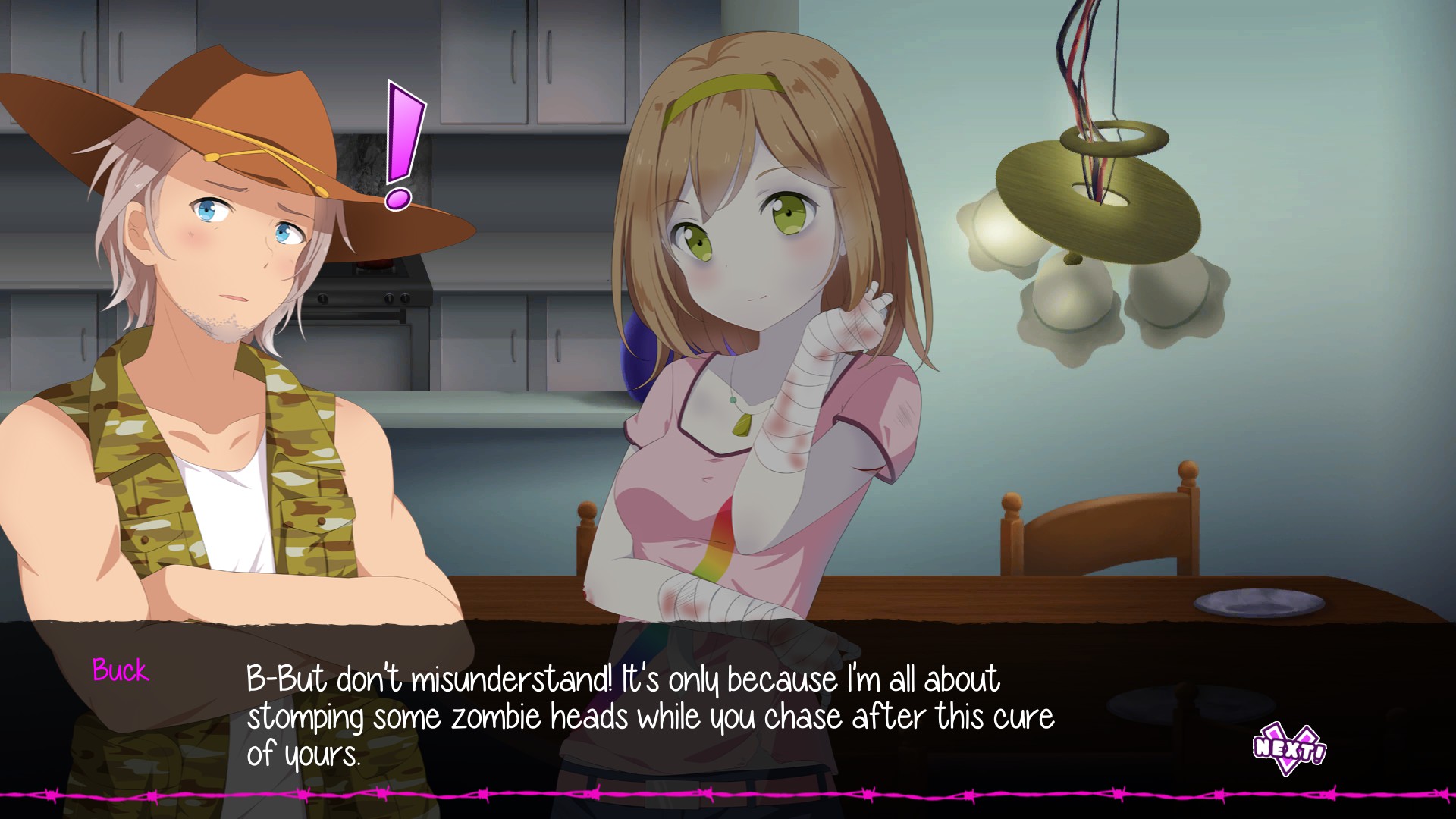
Kairi is the requisite actually Japanese person in an “anime inspired” story written by Westerners, and she basically falls somewhere between the anime archetype of the class representative character, the western stereotype of Asians having good grades in math because of insanely strict parents, and the “reality” TV archetype of the insane bitch. The former archetype is one I generally appreciate, but there’s a line between being bossy, being arrogant, and being outright abusive.
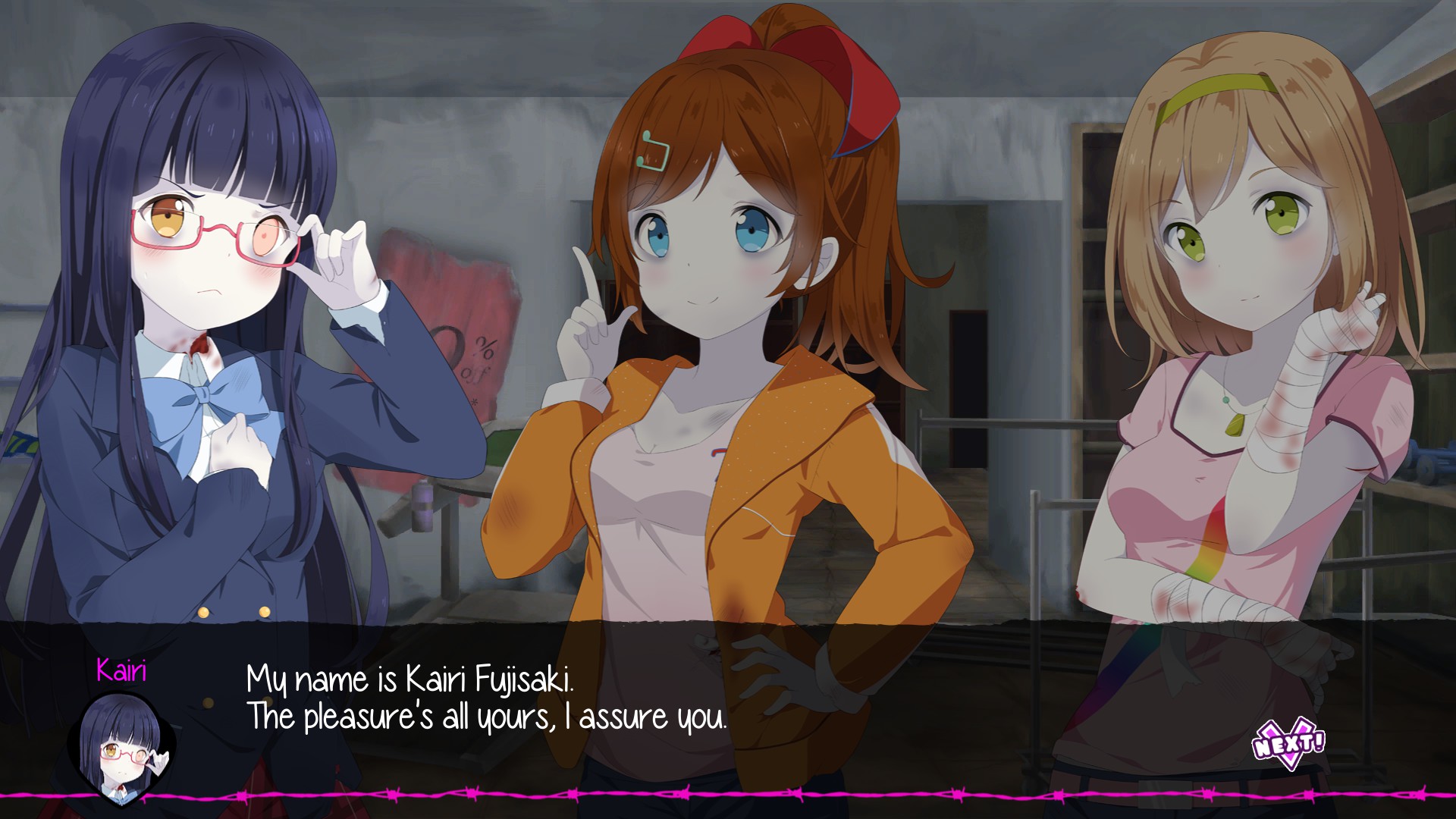
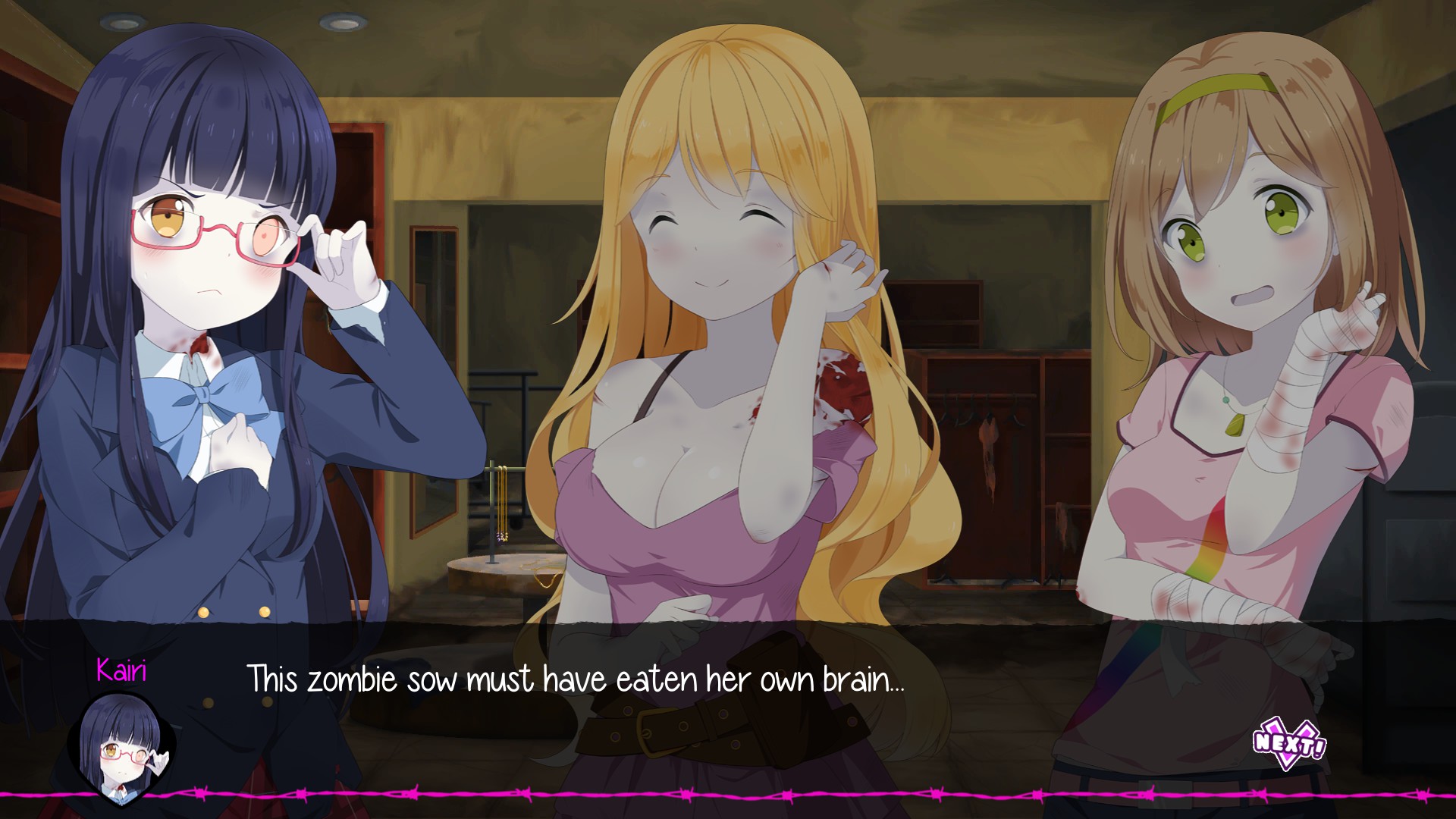
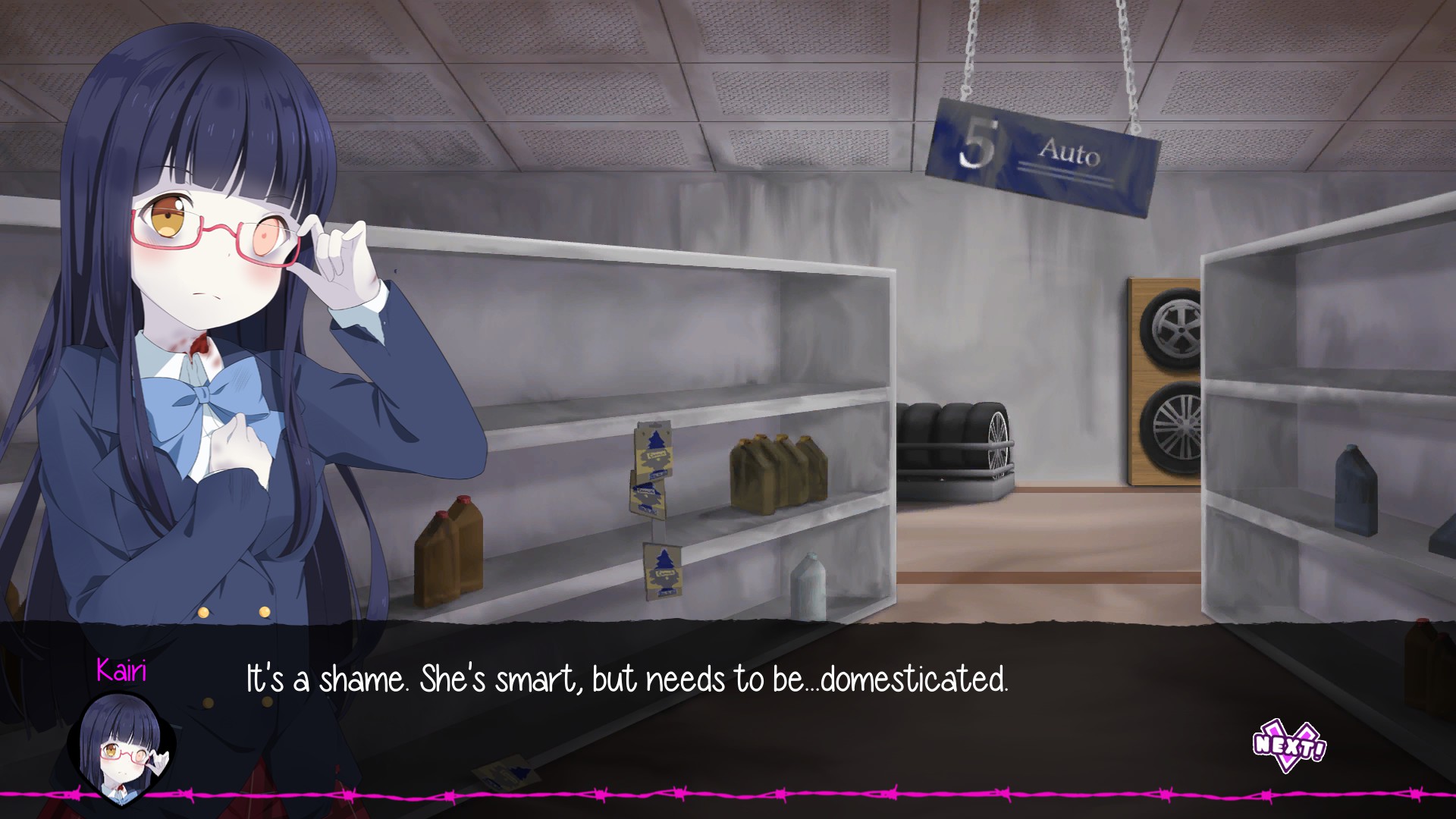
Many of Kairi’s lines involve insulting other character’s intelligence or belittling their concerns or interests to their face. I can, again, kind of see what kind of character they were trying to create, but I suspect many players will find her so abusive towards the other characters they like that they’re just going to wind up loathing Kairi before they can get to any part where she’s supposed to soften up and get you to like her.
Summer is the tomboy love interest, which this game stretches out to mean “dumb jock”. She introduces herself by demanding a one-on-one match with the only male in the party “to assert her dominance”, then says she was raised with a lot of brothers so she doesn’t like being treated differently because of her gender (… even though she’s clearly treating others differently because of theirs). Her dialogue options in events skew towards any choice that implies avoiding eating carbs or going on constant workouts.
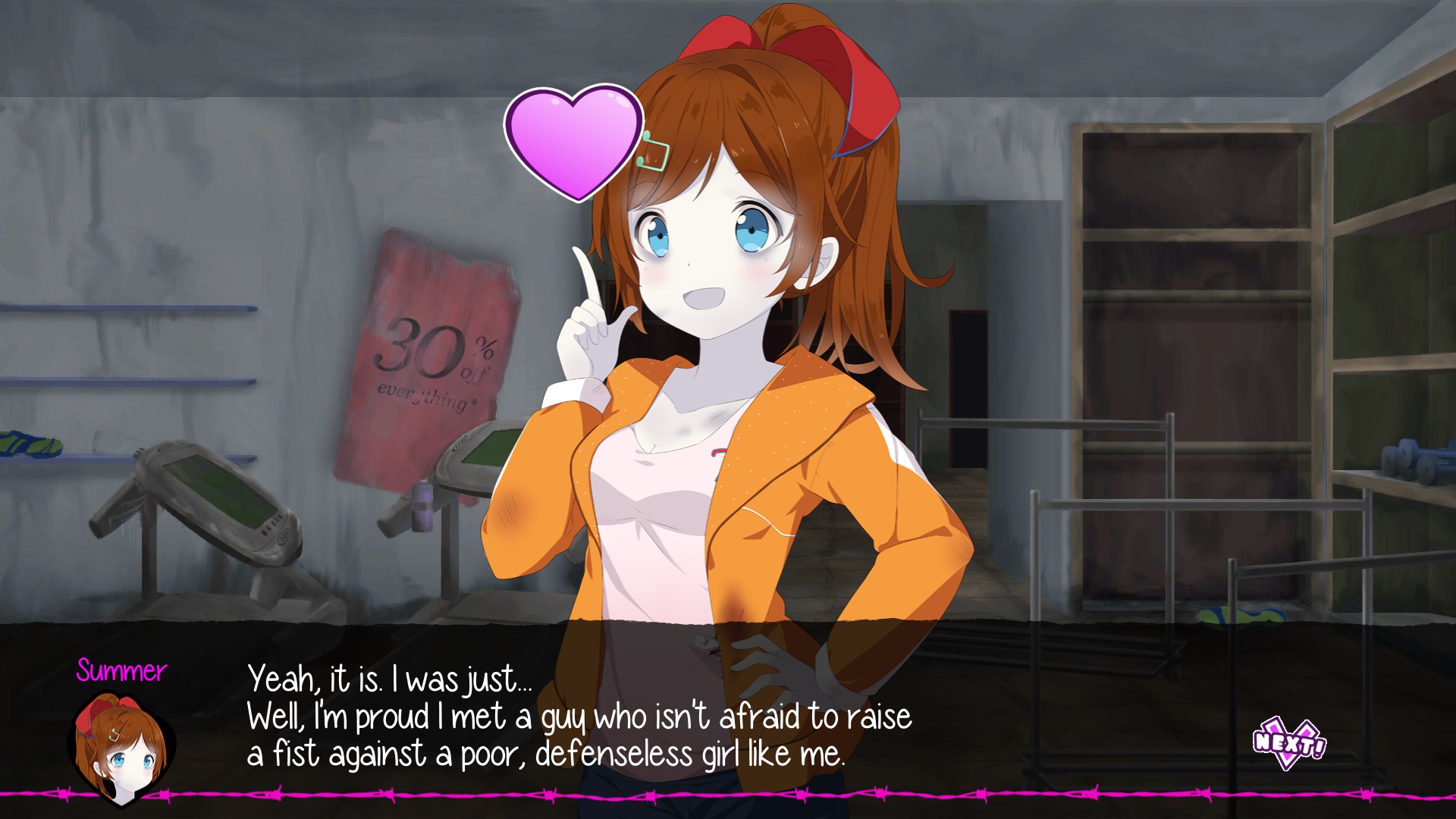
Her heavy stereotype aside, she’s not particularly humorous or out of place as a character.
Then there’s Cici. Cici is the sexually open big titty dumb blonde character, but oh no, this game doesn’t want you to think they’re just reusing that lazy and slightly slut-shaming stereotype, no sir! They’re going with the only slightly less common dumb blonde variant A, the “big titty idiot savant blonde”! This is a character that pushes being a ditzy airhead to such extremes that she can’t be let outside without wearing a helmet (seriously, one part has the party split up because she followed a bird deep into the woods), but then gives her one extremely narrow area of extreme expertise in the belief that it will be “shocking” that “such an idiot” who has consistently proven they’re a world-class pianist or have an eidetic memory or perfect match skills will continue to consistently display those talents, so that other characters (who apparently fail at basic pattern recognition) start to wonder “who the real idiot is” or some such. In Cici’s case, this is the creation of games on her “graphical calculator”, which introduces a “text-based adventure” (but still multiple choice just like the visual novel sections, just with more choices and less save points) you have to complete for affection points. (This is basically a massive “guess what the writer was thinking” or trial-and-error savescum fest.)
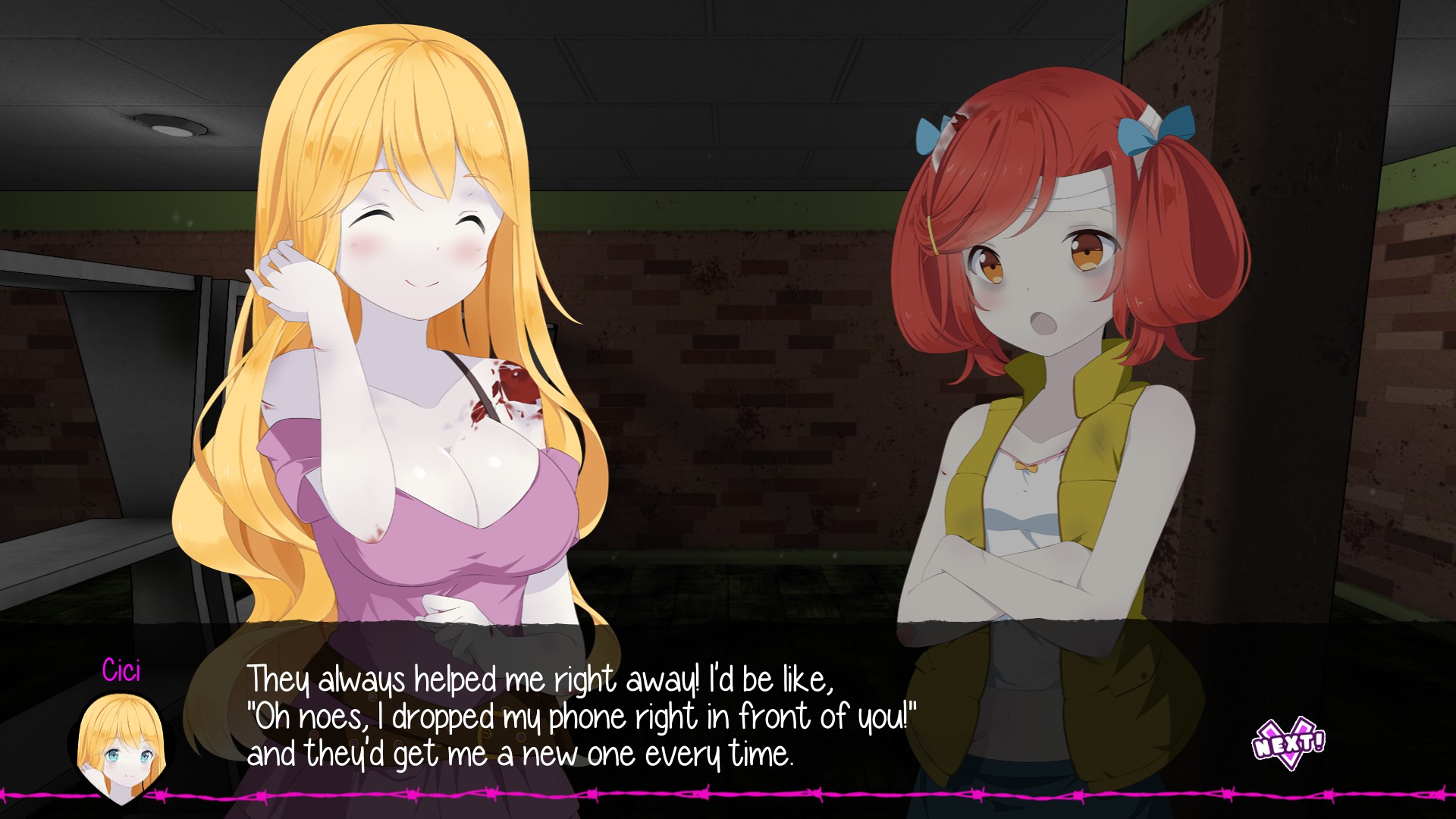
Cici is easily the most disconcerting character in the game, and besides Buck, the one that does the most to derail the tone. They clearly want to include the sexy blonde character, and have her own it, rather than being Innocent Fanservice Girl, but they also still want to play up My Girl Is Not A Slut, and so to thread that needle of having her flaunt her sexuality and flirt with Reggie (and the other girls) while trying to say she’s still definitely “innocent”, they put the blame all on, you guessed it, BAD PARENTING! You see, she only does everything her mommy told her to do, and her mommy apparently directly told her to be an airhead and deliberately bend over and pose so boys can see her panties. There’s something that’s honestly even more disturbing about removing the character’s agency to the point that they’re both the most sexualized character while also being the most childish to the point that other characters literally feel the need to babysit her to protect her from her own actions than just having her openly be “slutty” and just owning it.
You’ll notice there’s also a final character in the lineup… I didn’t get to the point where she joined the party, however, before hitting the deadline for writing this, so anything I’d have to say is speculation based upon character design, and I’ll just leave it at that.
Affection Points
If we were to continue the comparison to Real Life Plus, in that game, Kaname would jokingly reference needing to get more affection points for her to agree to kiss the main character, Undead Darlings, however, plays it straight.
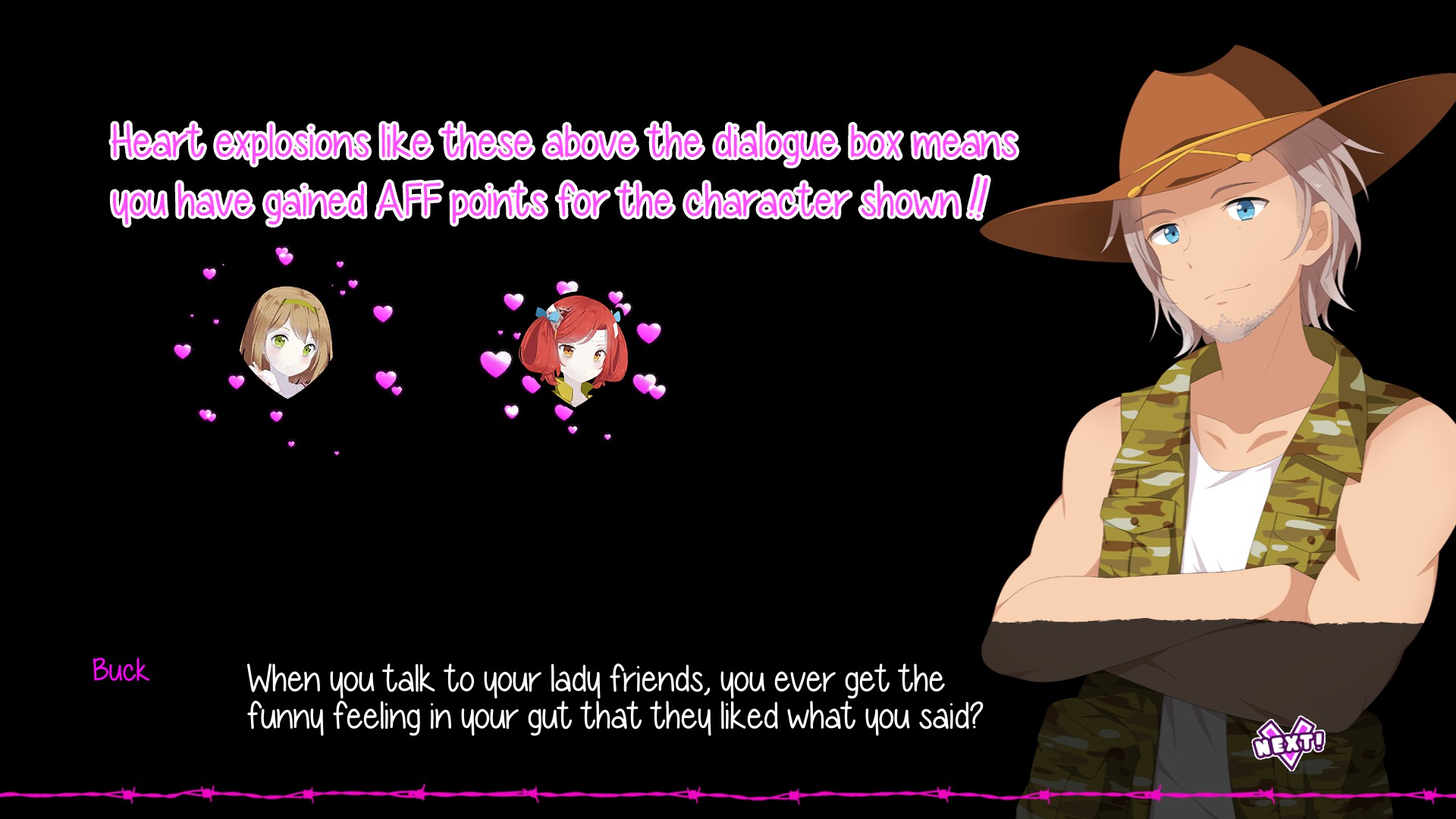
Affection points are gained from specific conversation choices during visual novel segments, about 3 points at a time whenever a proper choice is made, or just automatically at certain points in the plot is reached. Affection points are a stat that makes the girls you’ve been selecting the right answers for do better in battle… somehow. It’s not clearly explained how, but the tutorial assures me it does. Whatever it does is either subtle enough I don’t notice, however, or requires such high affection points that I haven’t gotten far enough in the game to actually activate anything yet.
I have played games, such as Magna Carta for the PS2, where relationship levels between characters could be changed with gifts and made characters more powerful, but were reset between dungeons. Obviously, players of Undead Darlings would get upset at actual resets, but it seems odd that Pearl is obviously in love with Reggie at the start of the game, but only has about 10 affection points, and nothing seems to trigger until you get higher up in the affection points, which would be much easier later in the game, but impossible early-game. I’d think having some sort of scaling of whatever triggers chances for affection points to activate whatever is supposed to happen being based upon how many affection points a player is likely to have at certain points in the game would be a good baseline way to make affection points matter early-game and let players see them working. Alternately, you could have the game subtract, some small number of affection points at the start of every stage so that you can start at a higher baseline with Pearl and Jordan, but need to work at least a little to keep their relationship from souring.
Gameplay
So remember when I said that whenever you create a game that mixes genres, it runs the risk of making one portion of the game significantly better than the other? Well, this is a game made by someone who primarily works on visual novels, so the visual novel parts are great, but the RPG parts are mediocre at best.
Wizardry-style dungeon crawlers tend to easily fall into a rut where you just mindlessly mash the “attack” button to put the pointy end into the squishy things until they scream and fall down. Some franchises like Etrian Odyssey (especially the later games in the franchise when they broke away from pure fighter/paladin/cleric archetypes) can manage to create a system where you need to rely upon constant use of skills to make fewer fights that last longer be more interesting. That said, as with the Legends of Amberland I reviewed before, you can sometimes just have simple combat that goes very quickly to keep things moving briskly enough it doesn’t wear on the player. It’s a sliding scale, where the speed of combat needs to match its complexity to keep from overwhelming a player with too much to do in too short a period of time or boring the player with too little to do in a long period of time.
The problem with Undead Darlings is that it’s both slow and simple, so it falls into boring combat territory. There’s a “EE” guage that, somewhat like Persona, tries to encourage you to exploit enemy weaknesses by giving you a damage multiplier you can use on your next turn if you only get chains of attacks on weaknesses, but that’s a problem when you can’t swap weapons out mid-combat, and it often is just plain faster and easier to ignore weaknesses and just spam basic attacks. Also, EE attacks have no guarantee of hitting, and about 40% of attacks in this game seem to miss, so trying to pin your hopes on using weaker elemental attacks that hit weaknesses to charge up a big attack using EE can backfire spectacularly when you whiff and waste it, as can having an enemy die before your next character attacks a random monster with an attack that they aren’t weak against, wasting your EE meter. You just wind up using EE if it’s there, but it’s not reliable enough to plan around.
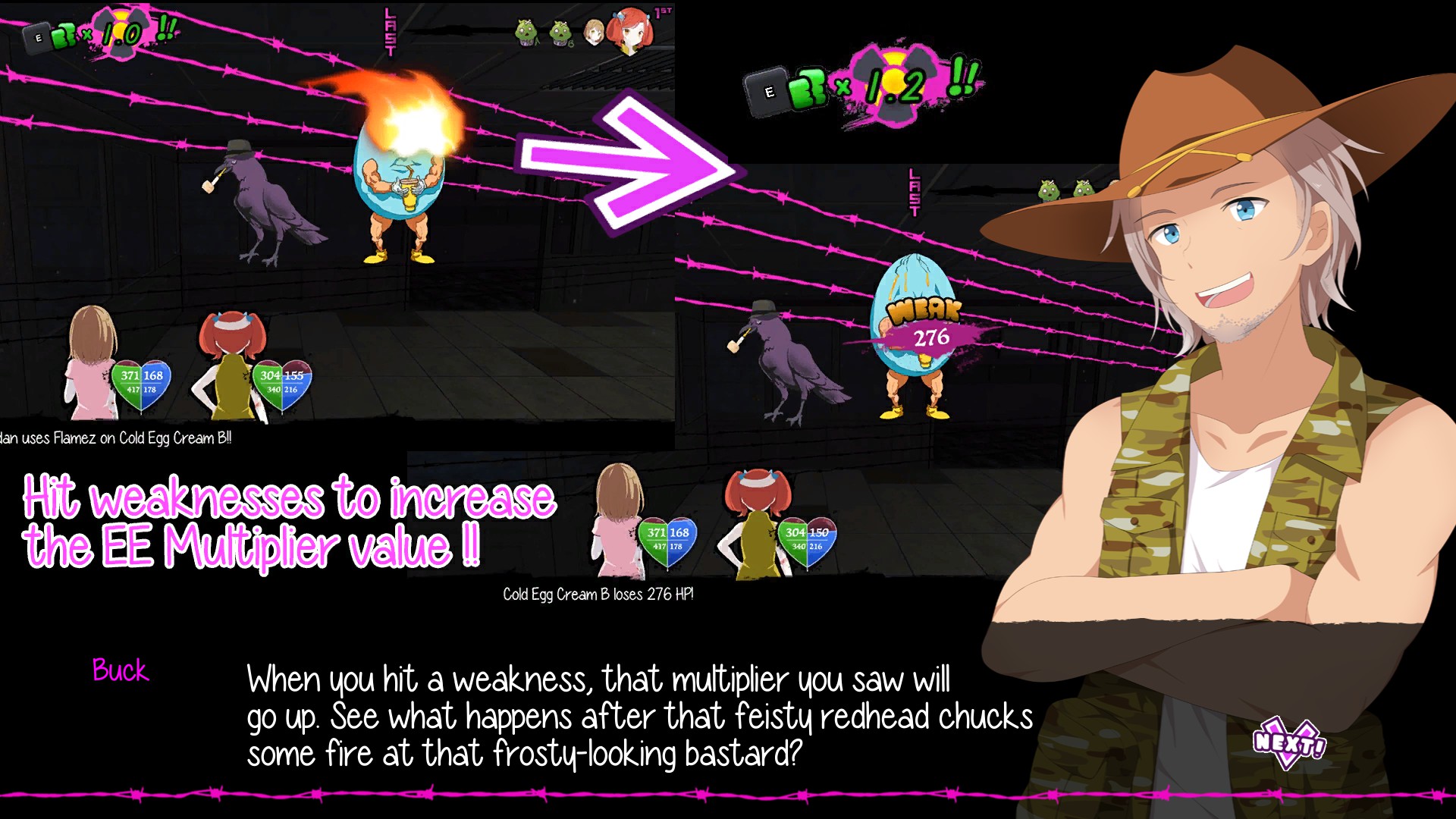
A major problem is that skills take far too much SP (basically, MP) for what they do. You get basic elemental attacks that cost 15 SP each, with ones that carry status ailments going up towards 45 SP when you have about 150 SP to start the game, and even mid-game, you’re only getting up to around 300. This wouldn’t be so bad if they were, like most Wizardry-style dungeon-crawlers, fight-winning spells that dwarfed the power of the fighters but which you needed to ration carefully. These spells, however deal the same damage that a physical attack would deal if the physical and magical attack values on characters were the same. They’re not the same, however, as you basically always want characters equipping weapons that make physical attacks much stronger than magic. So basically, you’re spending 1/10th your total SP to deal less damage in fights that often drag on for six or more rounds. This can hypothetically be used for charging EE, but since the attacks are weaker anyway, as mentioned above, it’s more reliable to just spam normal attacks than worry about EE. Spells are basically not worth using except for healing magic, buffing magic against bosses, or the special “combo” attacks.
Meanwhile, one of the other major types of skills are physical attack skills. These deal much more damage, letting you clear fights faster, but instead of taking SP, they take up the durability of your weapons.
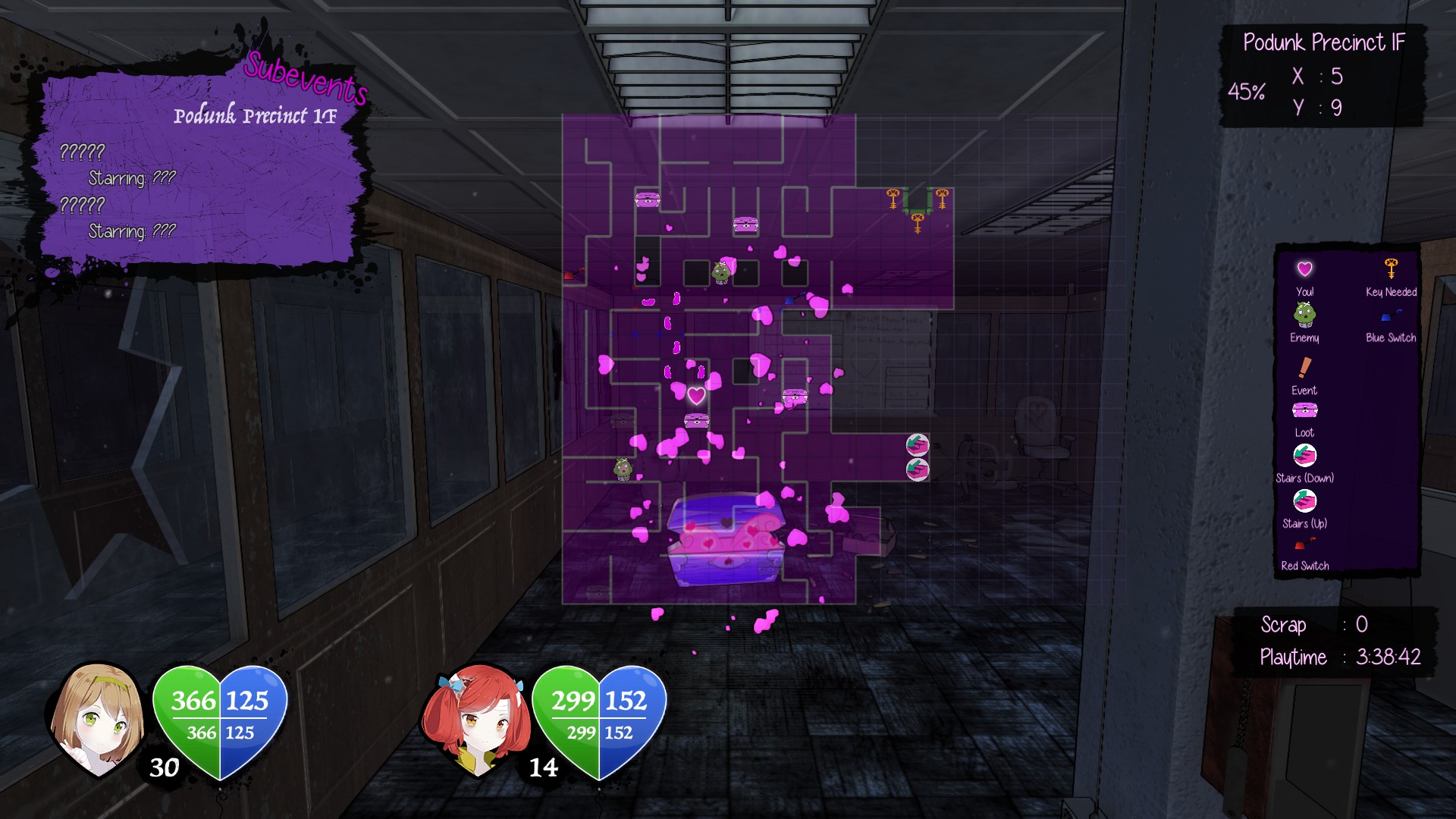
So far as exploration goes, however, it’s something of a mixed bag. I do think the environments are quite interesting, as the time was taken to make the labyrinthine layouts still have real-world objects at least attempt to explain their contents. I enjoy walking down a mall with a big “Gloomingdales” logo on it, and signs that say “All limbs must go!” and in the fine print saying it’s a tree clearing/firewood sale.
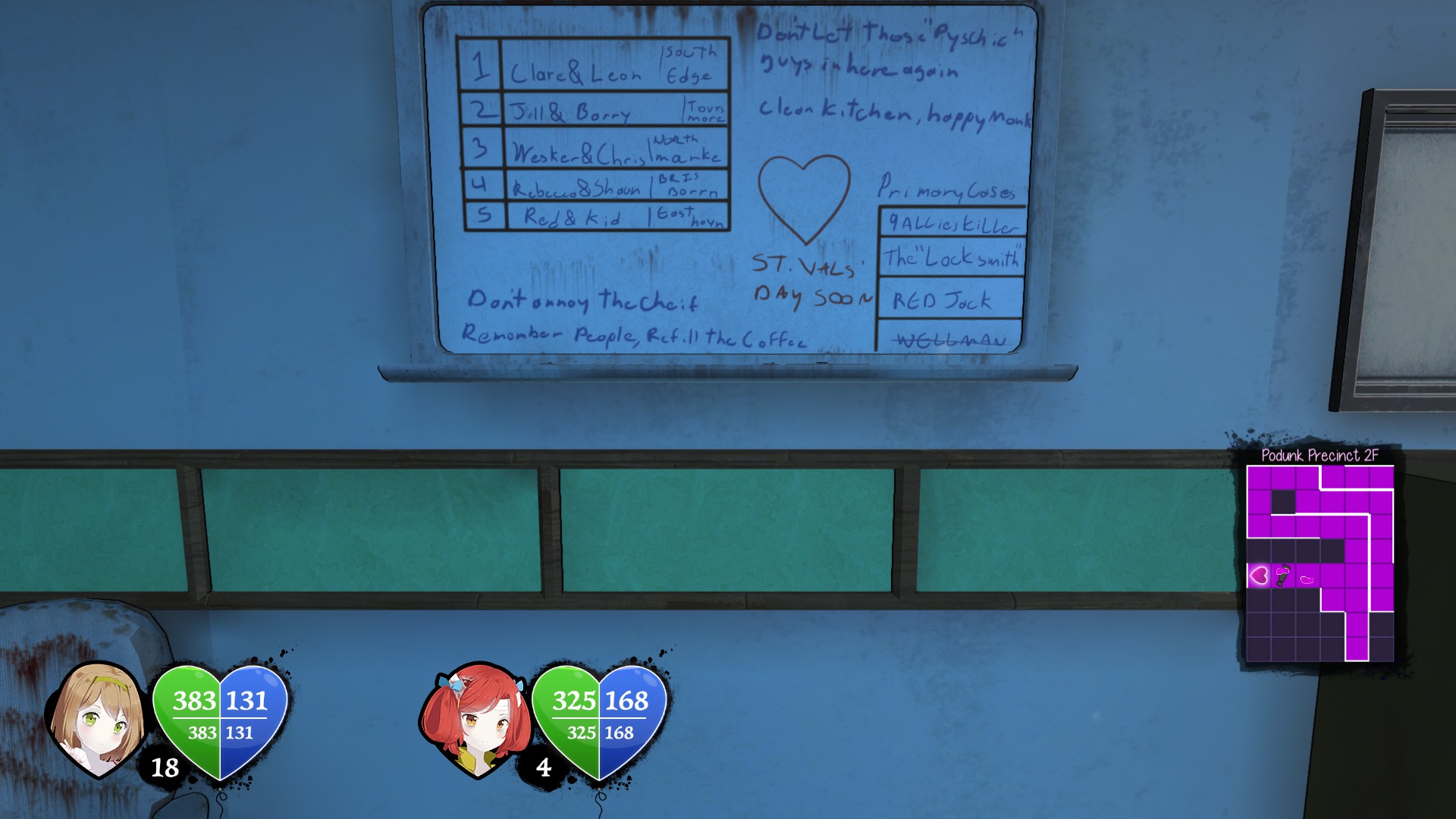
The need to make a nonsense labyrinth, however, makes most of the environments make a lot less sense. It makes sense to have some areas that should be open blocked off if it was under maintenance before the apocalypse hit, or maybe you could have layers of survivor barricades in the buildings where you have to find where the zombies broke through to wind your way past. The problem is, the environment looks mostly like it was always designed to be a labyrinth even before things went to the zombies. This wouldn’t be a problem if it was a nonsense maze like the arbitrary caves and dungeons in most dungeon crawlers that didn’t try to explain itself, but it does try to explain itself, so the flaws in the explanation stand out.
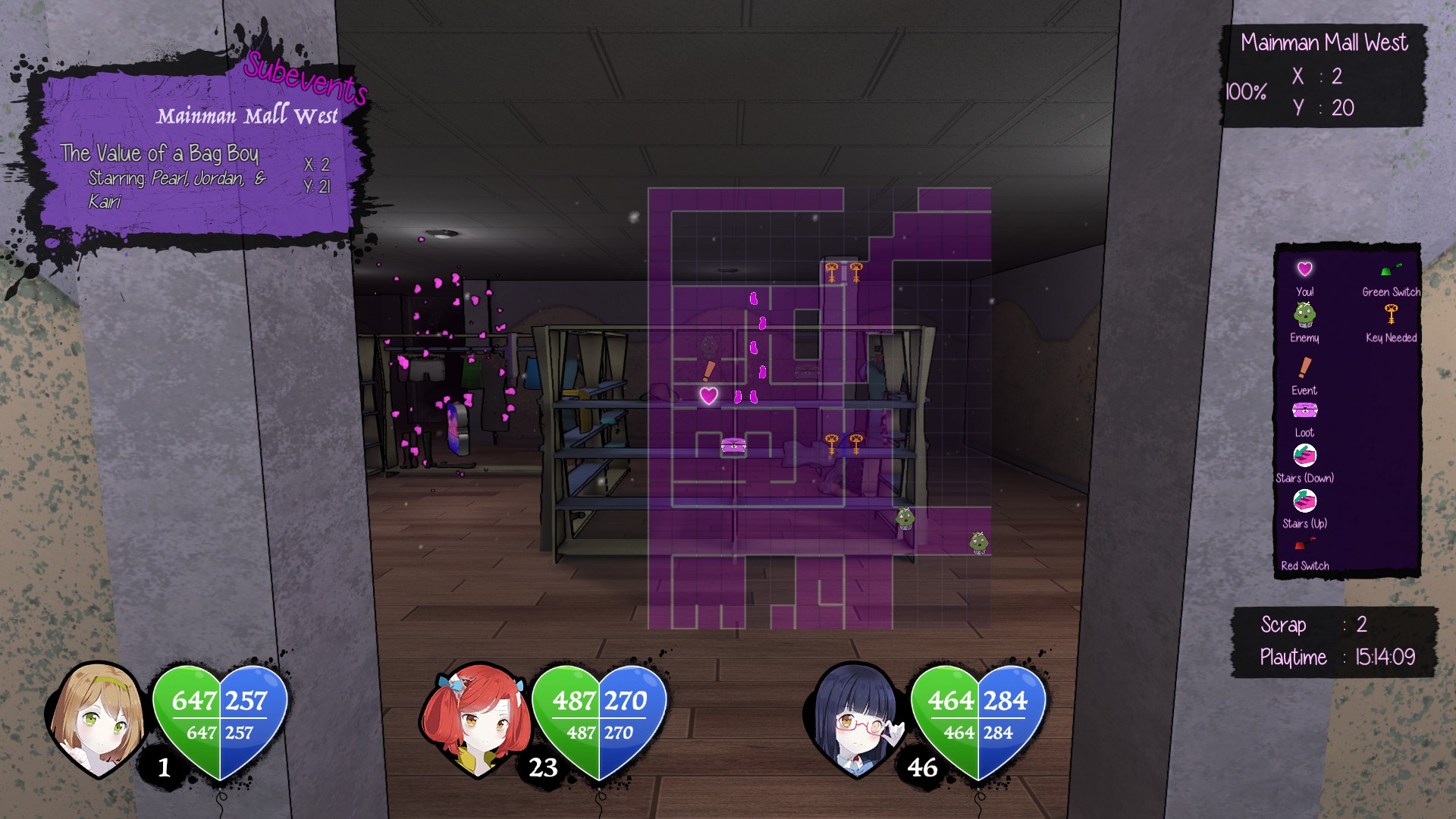
Pacing
Pacing in books and movies is the contrast between the “fast parts” where dramatic action is happening and the “slow parts” where the nature of the story and its characters are explained and the stakes are set so that the fast parts can be dramatic. If the “slow parts” are too long or too frequent, the story is boring. If the “fast parts” are too constant, the audience becomes numbed to the incessant explosions and nothing has any emotional impact. A good story starts off with a fast part hook to get the audience’s attention, goes to slow part character introductions and worldbuilding, then switches between the two in bursts so that both have their full emotional impact, yet raising the tension until the climax (a fast part) and a denouement.
Games do this too. In a classic RPG, the town has really soothing music because it’s the slow part where you get plot exposition. The combat is the fast part with the fast music, and the exploration is a part in between. Older games with limited spells and potions and long dungeons to get to a boss fight raise the tension as you have to expend resources to get further into the dungeon, making the player have to assess whether to keep going or turn back to resupply. This tension between whether you should press forward and risk it or play it safe and turn back is the equivalent to the raising stakes and dramatic tension of a linear story like a book or movie. (However, actually turning back, as I’ll discuss later, can ruin the pacing, so most newer games tend to “streamline” the game and make it easy to never turn back, even though that, in turn, winds up ruining the tension of exploration entirely in the process.)
With me so far?
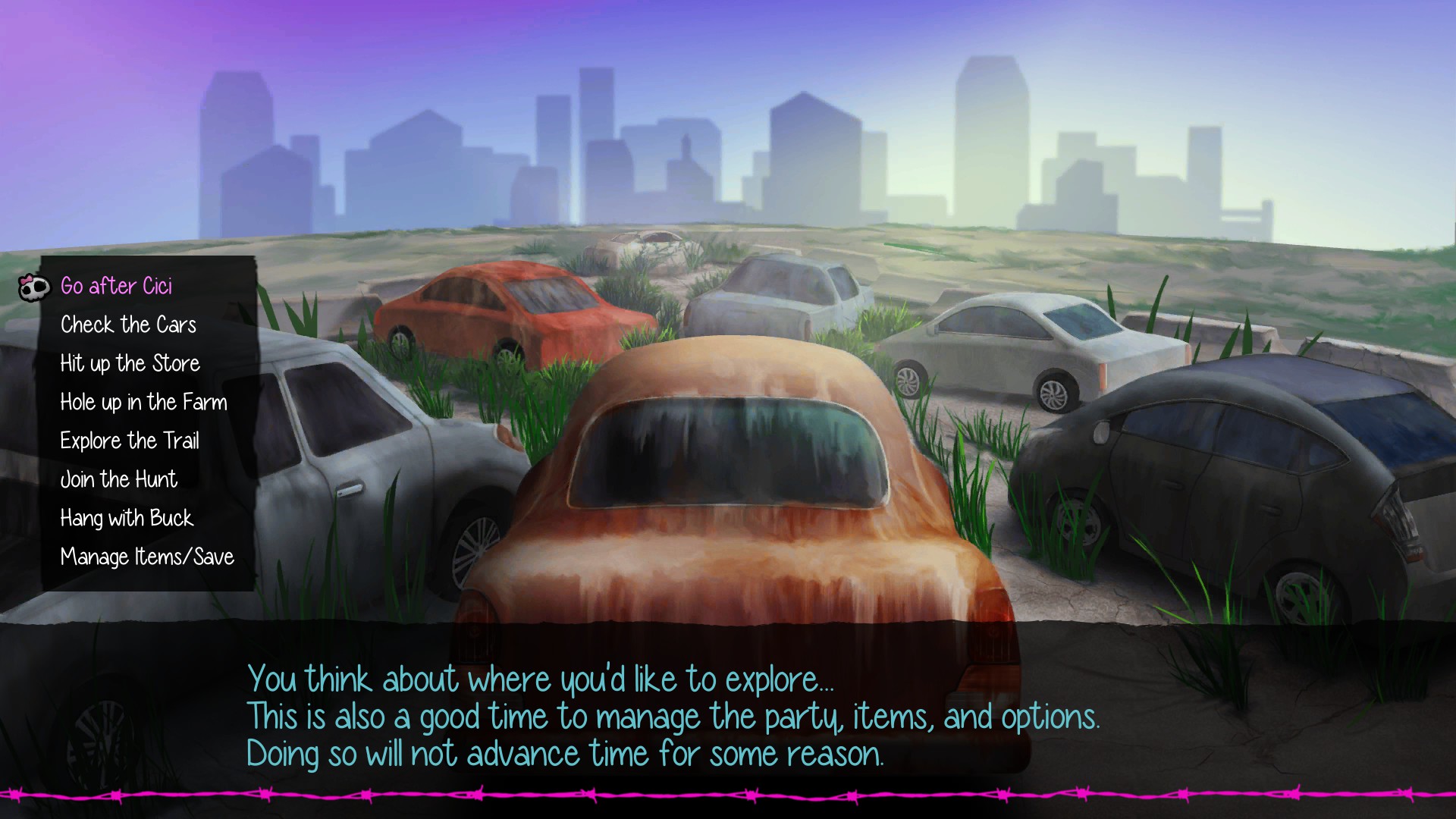
Well, the pacing in Undead Darlings is terribly off. It’s not so much that the “fast parts” are actually fairly slow, although that is a component to it. I mean that the visual novel parts stretch on for a fairly long time to the point that they start to drag and make the player itch to do something else, and then you have dungeon crawling parts that stretch on FAAAAAR too long, to the point that it’s hard to keep yourself on task and not want to just go play another game with some more variety. The simplicity of the gameplay itself probably makes me run out of patience for it more quickly than I would otherwise, but still, the game starts off with about 15 minutes of visual novel, then goes into a dungeon that took me 4 hours to clear (although I did manage to nearly totally complete the map before I found the boss, so I might have just been unlucky), and then goes into a visual novel section that lasts for about 45 minutes, then a dungeon that lasts 8 hours (although this one has more mini-visual novel parts breaking it up as you get new characters), then over an hour of visual novel part. The game realizes it has some extremely lengthy visual novel sequences, because it adds in ever-increasing numbers of save points during the dialogue portions.
This is especially problematic because I think the first dungeon is supposed to be a tutorial dungeon that’s over with quickly. You only have Pearl and Jordan, and there’s even less variety. After clearing that one dungeon and getting your first visual novel section in forever, you’re given three other girls in rapid succession before and during the next dungeon.
The first dungeon could honestly stand to be about half to a third as long as it is, just to keep the pace flowing. The visual novel parts could also really stand to be broken up with more gameplay between them.
Basically, the game needs to have more, shorter dungeons broken up by visual novel parts that aren’t stacked one-after-the-other as they are now.
To an extent, you can say this is what the mid-dungeon events are for, however, as they’re mini-visual novel portions in the middle of the dungeon. The problem with this is that they require specific characters that you cannot have in your party except by blind luck because you don’t know who you need in your party until you run over them. They also tend to be far inside the dungeon, and often behind several mandatory fights that respawn if you leave the dungeon to change characters.
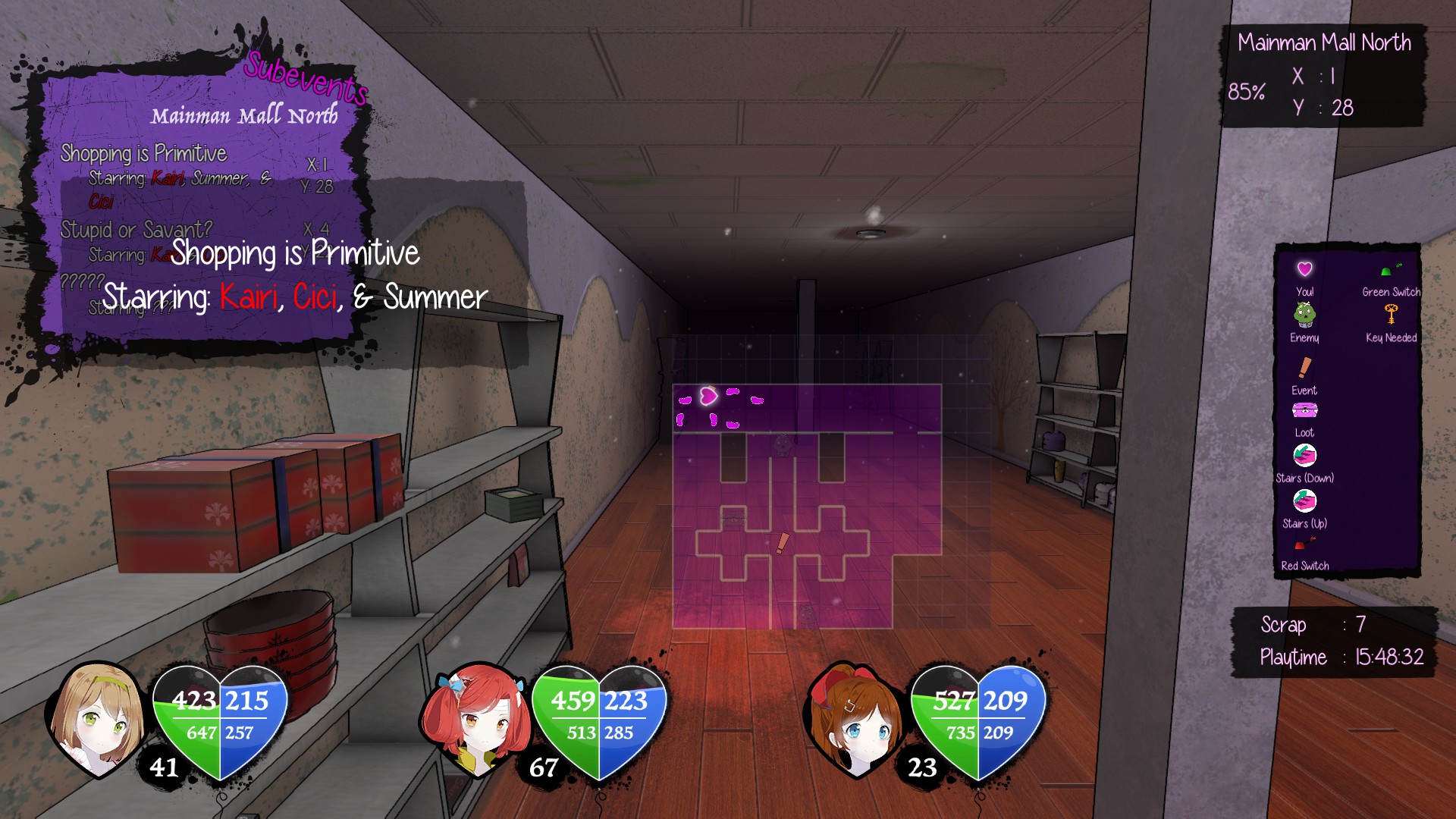
In other words, something that would otherwise be a good way to break up the grinding and backtracking forces more backtracking. Hooray.
I’d like to point out that major events, like meeting Cici for the first time, involves all four characters you recruited by that point even though you can only have three characters in your party. If they just had characters sitting in the “back row” or something, you would skip the backtrack and the events would be more a fun way to break up the grind and less a chore that adds even more grind to your grind.
Save-scumming and Backtracking
In most games, reloading saves to get different outcomes, especially from random elements, is considered “scummy” behavior, hence the name “save-scumming”, but some games also seem to be absolutely built upon the assumption that you have to get certain good outcomes to proceed with the game at all, and therefore save-scumming is mandatory. Visual novels in general are notorious for having multiple-choice decisions where one bad answer ruins your game, but they also let you save right in front of every choice, basically expecting you to reload.
Undead Darlings heavily pushes save-scumming in both aspects of its gameplay.
In the Visual Novel parts, the outcomes of most of your choices are wildly obtuse. Jordan will say something about a movie reference, and you have to respond with one of three movie references that will make her happy. There are some where it’s obvious, especially with certain characters whose pattern is easy to pick up, but a significant percentage of choices have one objectively right answer that is nearly impossible to discern from context how any of these vague prompts will lead to positive or negative outcomes.
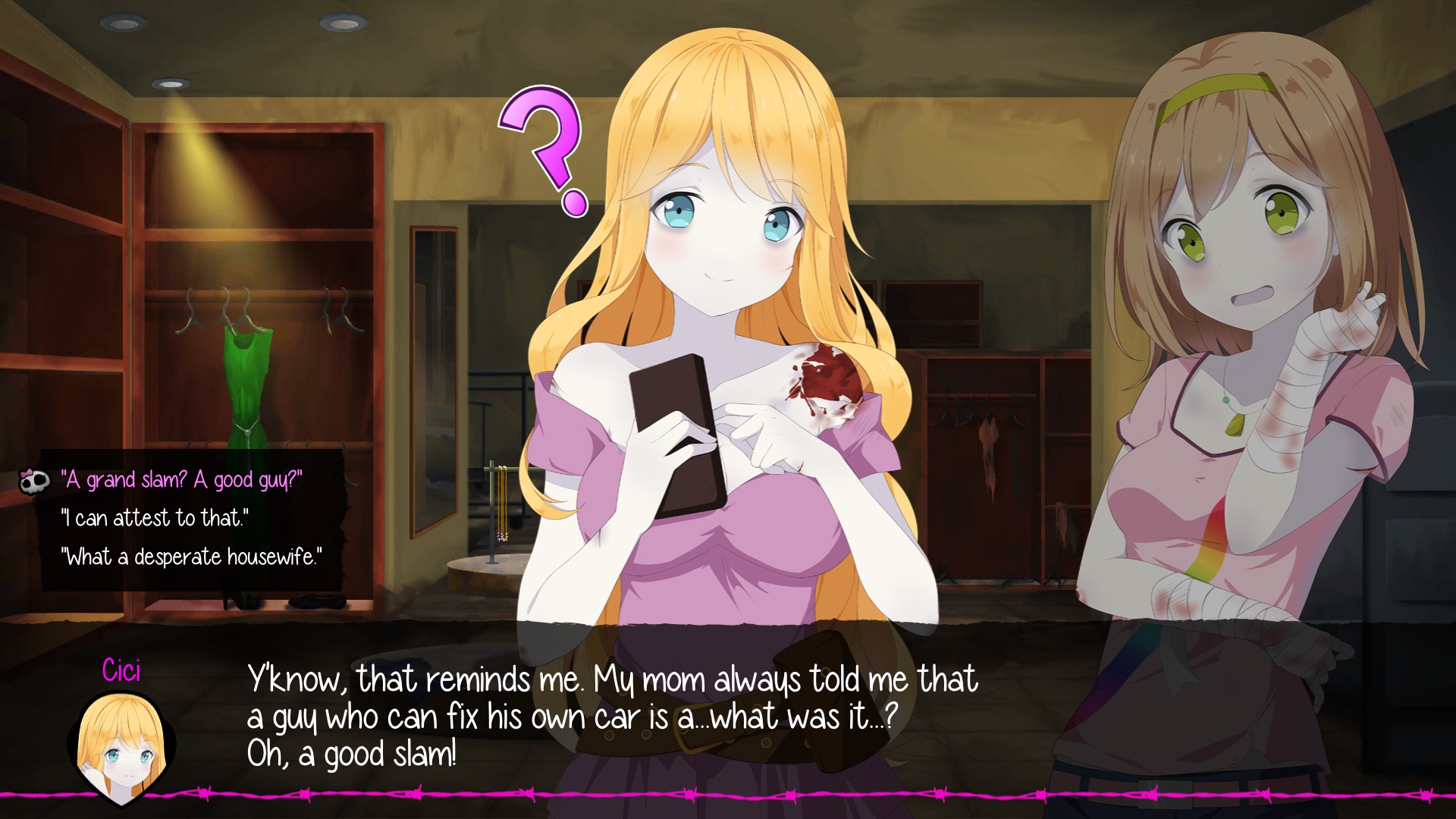
Again, most visual novels that pull this BS let you just save and reload nearly instantly from the point of the decision, so even if it is forcing you to save-scum to advance, at least it’s not sending you back more than a minute, and exploring every path of the branching dialogue is arguably what you’re playing a branching-path narrative for in the first place, and exploring every permutation of the dialogue tree can be fun in its own right.
Undead Darlings, however, doesn’t let you save mid-conversation, and has save points between dialogue sections that are quite long, even if you’re trying to skip dialogue because there is no skip dialogue button, and animations prevent you from just mashing enter to get through the text (which you have to press twice because it’s automatically set to a slow crawl…) so any time you want to see if another dialogue choice could have given you a better outcome,
And again, you probably need to make sure you’re getting maximum affection points with your chosen girl, because affection points come from these options, and that determines your ending, and is basically the point of playing this game, so you don’t want to screw it up just because the game was incredibly unclear about what any of the vague choices mean. You either reload until you get the best answer or you fail the game for picking heads when you should have picked tails on a coin flip.
There also are “best answers” to most of these. Typical dating sims that genuinely want to create a choice will often make you pick between options where you’re obviously picking one girl over another, and that helps winnow down the field until you’ve clearly picked one girl over all the others. These types of choices do occur, but they’re fairly rare in Undead Darlings, often being more along the lines of guessing what the writer meant by something and then having to reload and go through dialogue again to see if your guess was accurate. This often means having to read every part of the dialogue four times, and again, there’s no skip function.
On the other hand, you also need to save-scum the dungeon crawling, specifically the treasure.
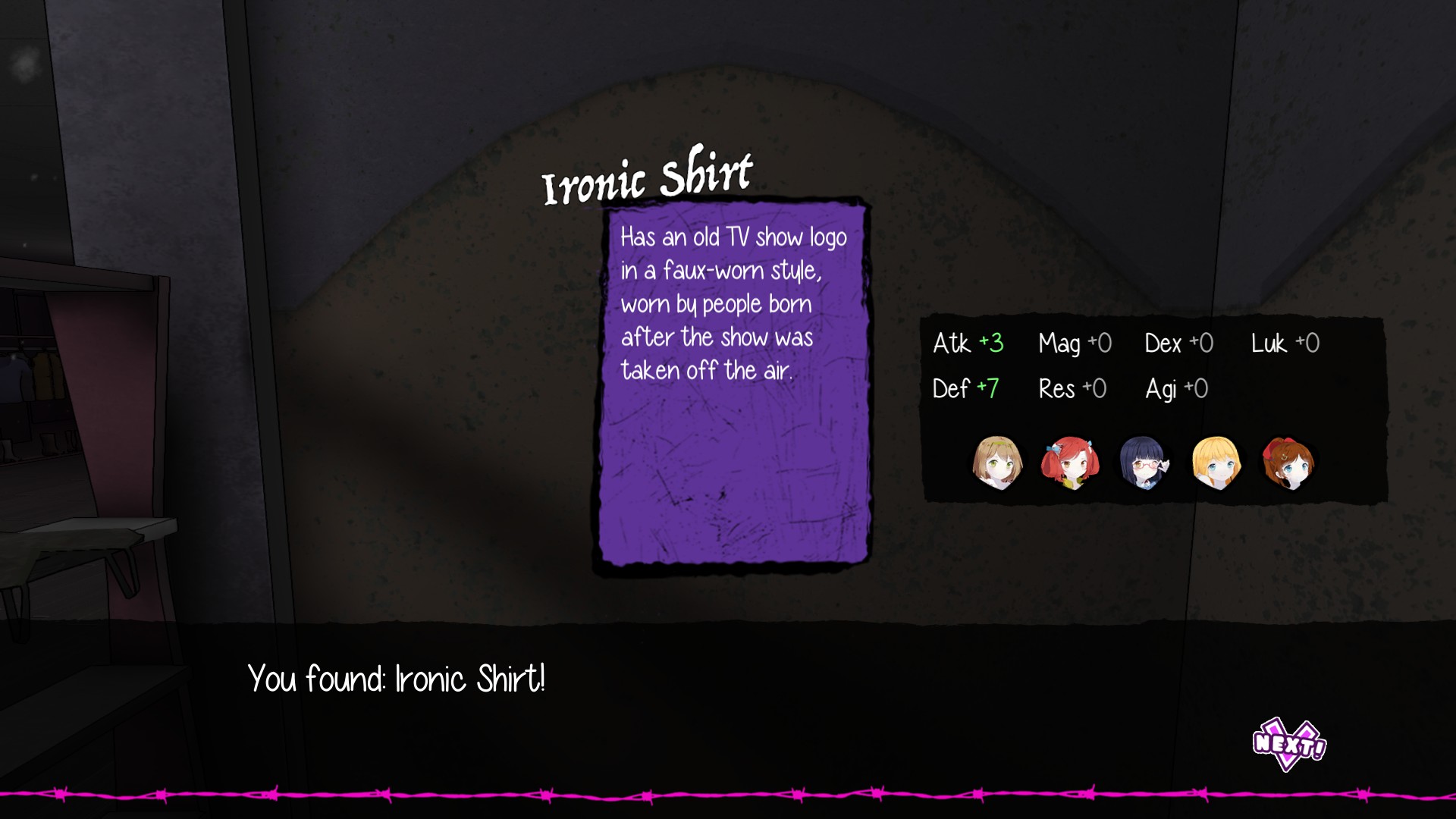
This game has durability in its weapons, and as previously mentioned, its magic sucks, so you want to use weapons all the time. This means you need to go through a constant supply of new weapons to replace the ones you break, and that means looting treasures constantly. Fortunately, they respawn every time you re-enter a level (even to go from one floor to the next floor, not just when you go back to base), so you can basically just reload to get more treasure.
The problem is that about 80-90% of the time, you’re getting candy corn (basic-level healing potion) or tactical flashlights (makes the room brighter, and doesn’t even help map), which are basically trash-tier consumable items. You will have a seriously difficult time surviving without all your weapons breaking if you don’t devote a significant proportion of your time just going to the base, heading out, going straight to the nearest treasures, going back to base, going to the nearest treasures, etc. to restock supplies because there are no stores in this game, just random chance on respawning treasure points.
Fortunately… sort of… the game does randomize items when you pick them up, not on entering, so you can savescum one step away from a treasure and keep reloading. Yes, it’s savescumming, but for the sake of your sanity, it’s absolutely mandatory you do this, because it means that every time you pick up candy corn, it’s only 10 seconds of loading screen instead of one or two minutes and possibly a random battle that tacks another minute on.
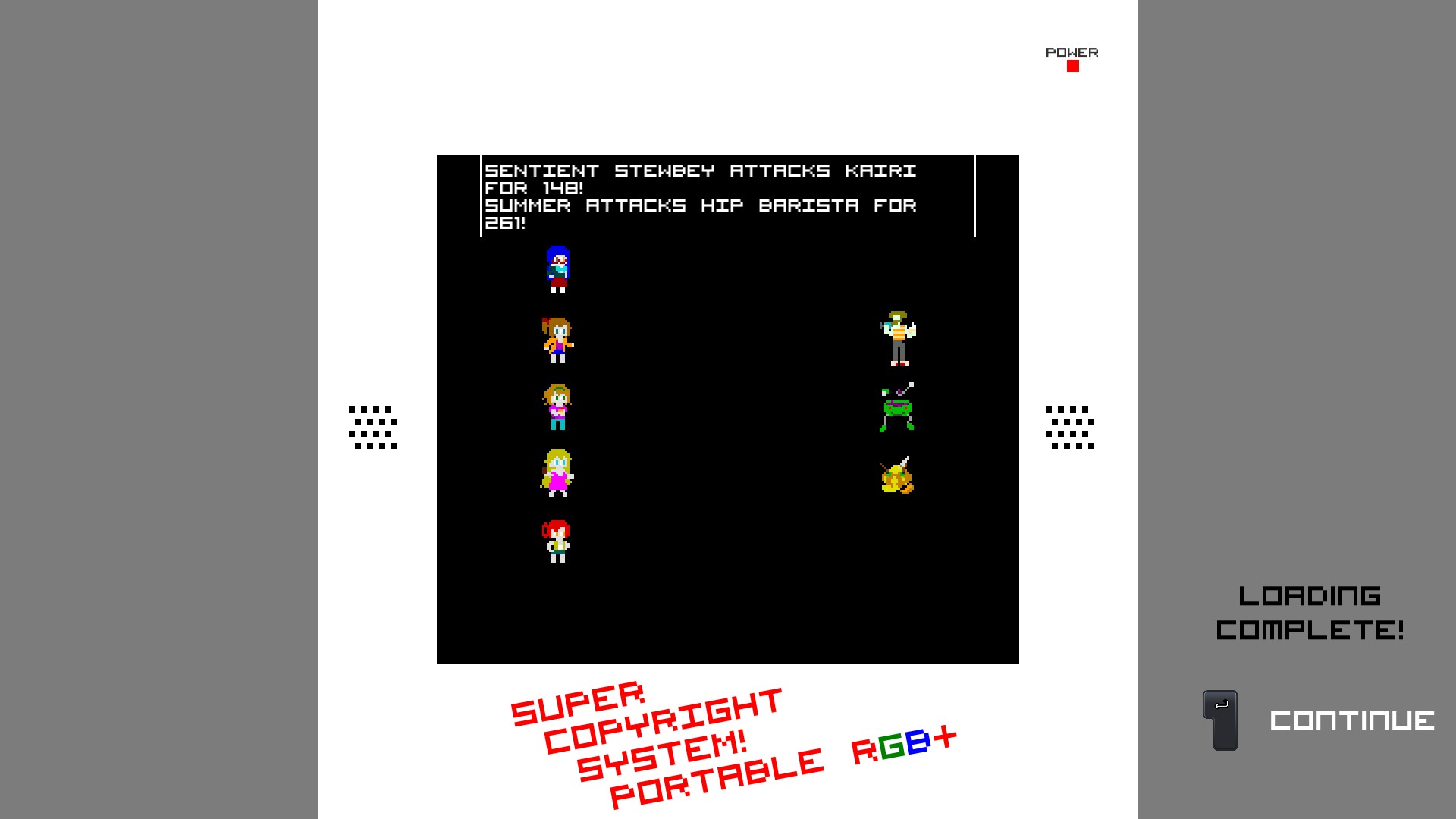
And in general, the problem with save-scumming isn’t that it’s cheating, but that it’s extremely boring. You essentially can’t get anywhere in this game without having weapons, and their drop rates are so terribly low that your choice is to be bored save-scumming in front of treasures or be even more bored constantly entering and leaving dungeons. I said that the first tutorial dungeon took me four hours, but probably two and a half of those hours was just trying to find weapons and watching the stupid loading screen. If you don’t do this, you wind up without weapons and you can’t perform the skill attacks it takes to beat harder monsters, so it’s just flat-out mandatory grinding the RNG, and it’s by far the biggest drag on this game.
This is in addition to the game being filled with colored locked doors and keys and needing to throw switches forcing you to backtrack through the maze repeatedly until you randomly stumble on the right thing, as well as go back to base and swap out party members to trigger mid-dungeon events. It greatly stretches out the boring slog portions of the game.
Oh, and speaking of backtracking, you can go back to dungeons you’ve previously completed, which you need to do for all the events because the first dungeon (which you go through with only Pearl and Jordan) has events for characters that appear later.
Interface
Once again, an indie game with some charming elements is plagued with a long list of things that are little annoyances on their own, but are so numerous that they add up to a massive frustration where you fight against the interface more than the monsters. That said, this is a beta, so hopefully they’re temporary, but making as much noise about them as possible helps to make sure that will happen, so if you’re interested in the game, make sure to make noise about the ones you care about to the developer, too! In no particular order, here’s the list of problems the interface faces.
1) All PC games should have rebindable keys. I have no idea why indie developers are so terrible about this nowadays (I think it’s all the developing for consoles first…), but there’s no excuse for there not to be rebindable keys. There are people who don’t use English-language standard QWERTY keyboards, and even without people wanting to rebind them, just having a menu that shows all the key bindings helps people know what keys are used, since there’s no tutorial for them in this game.
2) In the tutorial section, Macros are referred to as “auto battle”. Well guess what? Just mashing enter constantly lets you attack the default enemy in six button presses. Going to the “auto battle” takes seven button presses if you are using Macro A, and it takes more the further down the list you need to go. Macros don’t set you to auto-attacking, either, so it’s a “time saver” that takes longer than doing it normally. Combined with the problems in not being able to target specific enemies with macros, and they’re nearly more trouble than they’re worth.
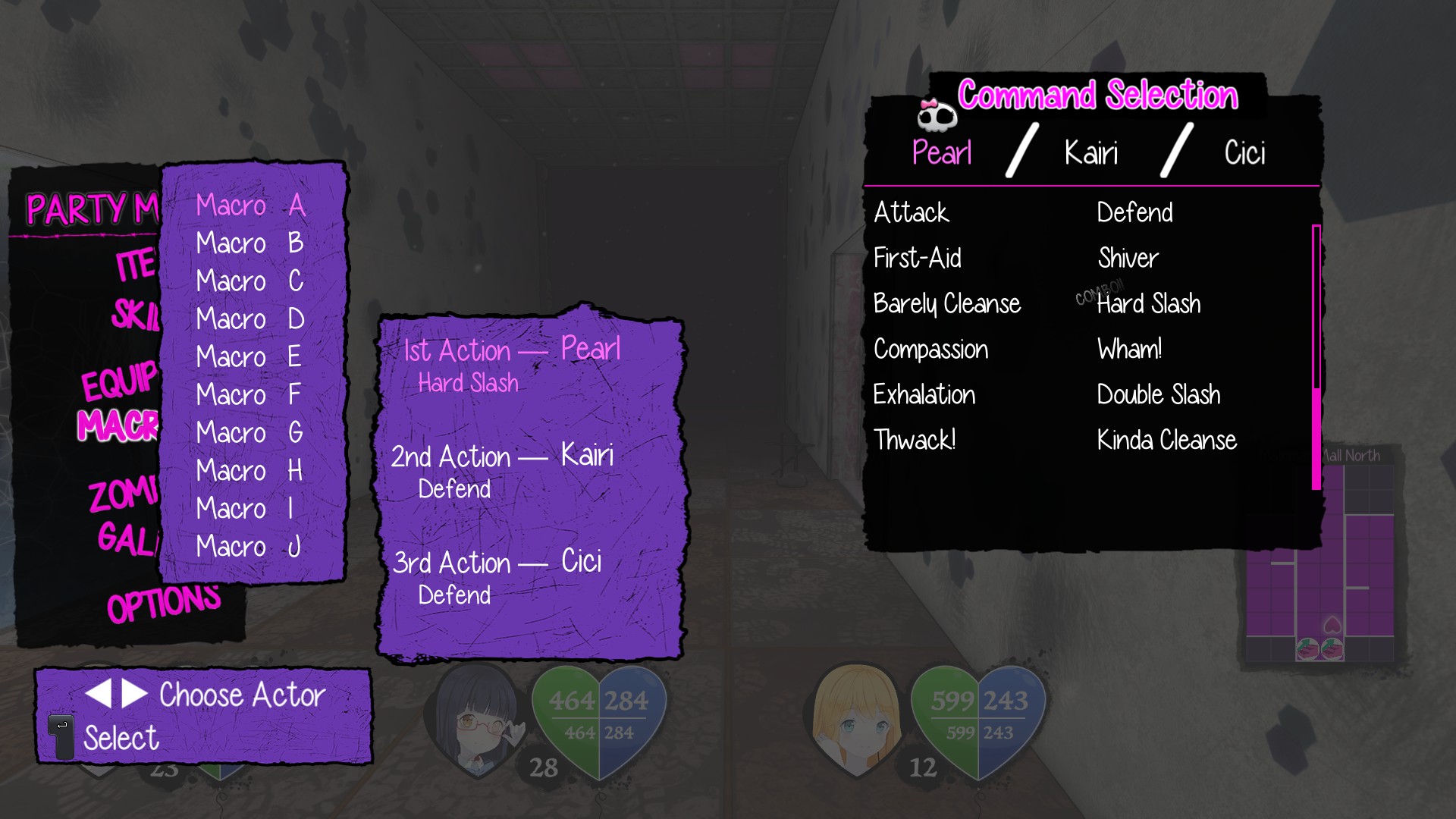
3) In the same vein, there needs to be scroll up/down for the menus. Navigating menus takes far too long, and the more the inventory expands, the longer it takes. Just going up and down the list of commands in a battle takes over a second per character per command per round. The time it takes for commands to be accepted and the animation to complete so I can punch in the next order (like moving down a list or the delay before the next action) isn’t much on its own, but since battles can take a dozen rounds where all I’m doing is mashing enter waiting for it to be over, most of the game is spent with me just waiting for the interface to catch up and get on with it. I can’t even just push up from the top of the list to go to the “options” on the bottom of the menu when I want to save, and as mentioned in the previous section, you do that constantly in this game.
4) On that note, I’m quite thankful for the option to have a fast forward speed for combat, but the choices basically amount to “slow, slower, and insufferably slow”. I’d like to point back to how Legends of Amberland had speed settings and cursor memory that let you just hold the button down and mow through monsters like a chainsaw if you were geared properly or high enough level. The combat there was similarly uninteresting attack spamming, but at least it had the courtesy to waste as little of my time as possible!
5) There should be a text speed customization, or at least a button that sets text to instantaneous. I know this game is trying to copy Japanese games, but there’s absolutely no reason to have that same ludicrously slow text crawling speed Japanese games have. Japanese is a far more compact language – English-readers will go through text at least four times faster than you can expect Japanese readers to go through it, and it’s absolute hell trying to read something that makes individual letters crawl out slower than my reading rate. There’s no good reason to have text print out in some lugubrious trickle in an English-language game.
6) Speaking of things Japanese language visual novel games have that this game probably should copy, how about a text log so that if I am so trained to punch enter twice to make the text complete faster that I accidentally skip a line, I can go back and read it?
7) The sound options should be saved to a universal file. I set the music volume down and character voices up since some character lines are so quiet they fade into the music (you need to spend more time leveling the audio – there are several lines where the same character will say one line very quietly then the next line is much louder), but that all goes away if I ever go back to the main menu or restart the game! It’s all back to 50 for all sound settings because there is no global setting save. (At least this isn’t a game that has everything blaringly loud in the splash screen, but this is still something that shouldn’t happen.)
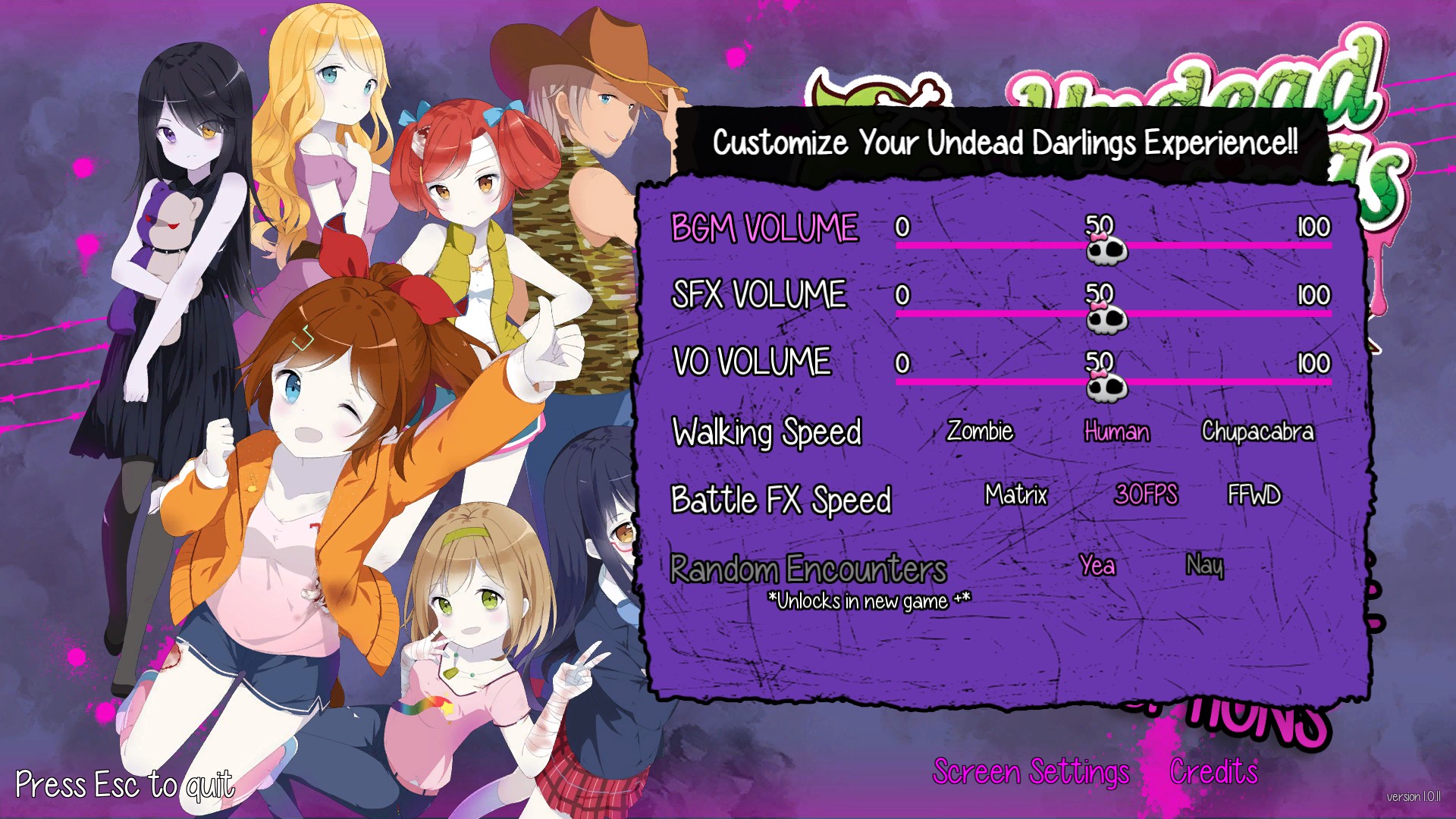
8) If you aren’t going to give us the ability to run from a boss monster (again, that’s basically a demand to save-scum just to find the boss’s weaknesses and what party members to bring), at least let us have some way of returning to the main menu or reloading a save without having to just Alt-F4 when it’s clear you’re stuck in a loop of using revive items only to get that character killed again.
9) There is no way to change equipment unless you are in a dungeon. This is hugely annoying when you collect new equipment like armor that might be useful for someone who isn’t in the current party, as it means having to go back to base, swap characters, go into the dungeon again, use the menu there to check if the armor you just picked up is better than what they’re already wearing, go back to base, swap characters again, and then go back into the dungeon to continue the game.
10) The general lack of ability to use the options menu while not in the exploration mode is a massive pain. Most Visual Novels let you just save whenever or change the volume whenever. What value is added to the game making players have to go through fifteen minutes of these things to hit the designated save points before you can make adjustments to these things?
Finally, and this is not so much a “flaw” to me, but I can certainly understand many people having a hangup about it: There is no mouse support. Zero. It doesn’t do a thing. I’ve always been kind of annoyed with having mouse controls in a dungeon crawler (and in particular hated the Eye of the Beholder series for forcing mouse control through menus to select spells from lists in real-time combat), but I don’t see why you can’t have mouse controls for the visual novel section. (Add in the industry standard right-click to remove the text box and mouse wheel to go through the text log while you’re at it!) I can only assume the game has no mouse support because this game is being designed with consoles and controllers in mind.
Macro Migraines
In addition to the problem of not being able to use Macros as auto-battle because they take longer to select than just spamming attack and also needing to reset them every time you swap characters, which the game makes you do constantly for mid-dungeon events, macros are also crippled by not allowing you to select what you’re targeting. To give an example, the first boss in the game is weak to the first combo attack you can perform with Pearl and Jordan being forced in your party. It makes the boss fight significantly easier (or go from impossible to possible, depending on character level, difficulty level, and loadout) if you first use the defense buff on Jordan (who’s weak to the boss’s attacks) and then spam the combo at the boss.
Then comes the second boss fight. It has two bosses, and one is physical attacking, but only weak to a few magic attacks, and the other is magical attacking, weak to physical attacks, and can heal the other one, but is in the second slot. Clearly, you’d want to kill that guy that heals the first one that’s more tanky first, right? Well, too bad, the macros won’t let you do that, so you have to either grind down the physical one with attacks that it’s not vulnerable too in order to kill it hoping you aren’t wasting too many turns if the magic one randomly decides to heal the physical one, or you can abandon Macros entirely.
You don’t use macros in regular fights, again, so this lack of any kind of control practically makes the whole macro system useless, and it’s another chunk of game you just have to ignore because it can’t perform its function properly.
Sound
The splash screen has a surprisingly good song with vocals, considering how many western visual novels don’t have the budget to hire anyone with talent. (And don’t get me started on dubbed anime songs where they have to force words to fit a tune in another language…) Due to the nature of how much you grind the dungeons, however, I heavily recommend playing your own track list for the actual dungeon exploration.
Voiced lines are either incomplete as I am playing a beta version, or else are limited to only certain sections of the dialogue. Having only certain “important” dialogue voiced while the rest is not isn’t too strange in branching dialogue visual novels with limited budget and tons of dialogue, but it does surprise me that some of the dialogue you can’t skip, like the pre-dungeon dialogue, will not be voiced, while some optional points will be.
So far as the quality of voice acting, the characters act their lines (as cartoonish as they often are) believably, and the only things that stand out to me are how absurd Buck’s “southern drawl” or Cici’s “sexy, breathy voice” sound, but they’re also the characters that are the most strange and cartoony. Likewise, I don’t recall any problems with leveling or popping, so the sound quality is, at the very least, nothing that will pull you out of the game world (any more than the story already does).
Sound effects aren’t a major highlight, but they’re functional. One thing I find odd is that there are varied sounds for footsteps, however. There are different sounds for different types of floors, which would be a nice detail in any game, but even on the same floor, different sounds are seemingly randomly played, from a sharp “clop” to something more like a thump or shuffling drag sound. Is this supposed to indicate some of the girls are running into walls or something? It’s kind of distracting, but has no gameplay or story impact, so… just ignore it, I guess?
Visuals
Anime art styles can be somewhat divisive, but in terms of pure artistic utility, the characters are cute in a visual novel about cute girls, and the enemies are well-drawn and entertaining in their design. The pink barbed wire and zombie cupcake aesthetic help sell that sort of half-Hot Topic half-cute punk aesthetic the game seems to be going for.
The one point where it falls a little flat are the backgrounds in the visual novel sections. I’m not sure if the artist just only puts their best into character design or if they had someone else do the backgrounds, but they clearly don’t match the style of the characters, and they have obvious perspective issues in places, giving it a flat and disjointed look.
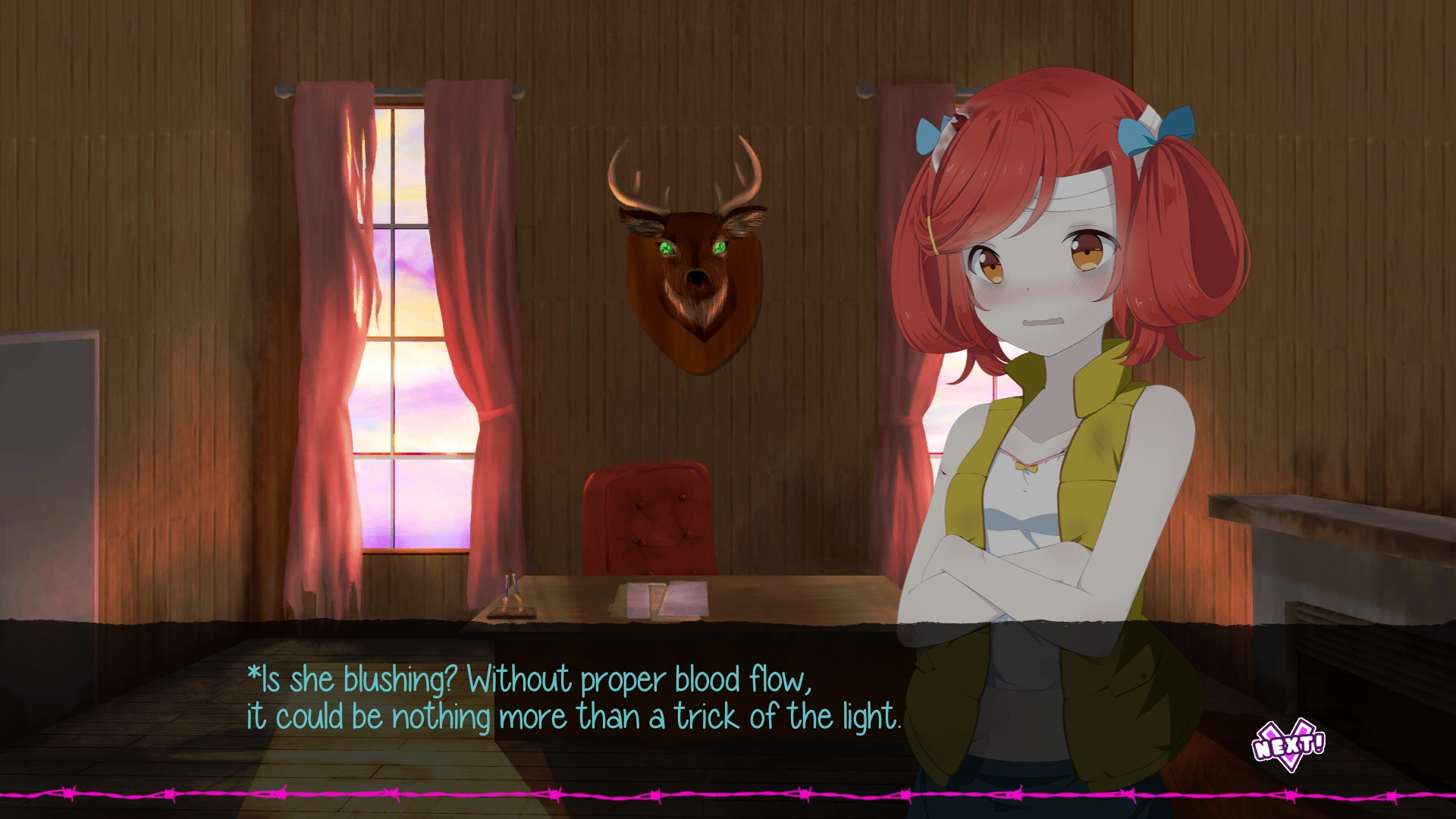
Verdict
A genuinely amusing story elevates bog-standard dungeon crawler gameplay above mediocrity. I genuinely want to see the story through, but the dungeon crawling tends to overstay its welcome.
I spend a lot longer on my criticisms for this game than my praise, but that’s because (A) I hope the developer reads this and makes some changes to at least the low-hanging fruit like interface to make the game better, and (B) the game’s positive qualities lie in its writing that is harder to describe why it works or doesn’t work without going into an outright novel-length deep dive into its politics. In terms of dungeon crawling, the previously discussed Amberland was a better game, but it was a flat monotone of killing things to clear a cave to go to the next cave where you kill more things. Undead Darlings is a vastly better story, so I actually want to see it through, but the gameplay is just a serious drag on the story.

